50 Creative Ideas to Nail Your College Presentation

We’d be willing to bet that most college students enjoy presentations about as much as they like their 7am class. Whether they’re designing them, or in the audience, there are likely a million and one things they’d rather be doing (like napping in their dorm room). In fact, 79% will say that most presentations today suck. And 35% of millennials say that they will only engage with content they feel has a great story or theme. With a reputation like that, it’s no wonder students avoid presentations at all costs.
As a result, many will end up procrastinating, losing sleep over choosing a topic, and piecing a deck together at the last minute. According to research, 47% of presenters put in more than eight hours into designing their presentations. You do the math. Eight hours at the eleventh hour equals an all-nighter.
Luckily, that doesn’t mean the final product has to be a poorly thought-out frankendeck.

Creative presentation ideas for college students
A lot can ride on a class presentation. It might be your last project at the end of the semester that determines the fate of your final grade, or maybe it’s a group project that counts for half of your participation in the class. Whatever the stakes are, we’re here to help you nail your next college presentation.

Pick the right topic
Before committing to your topics for presentations in college, you should consider things like what excites you, what you’re knowledgeable in and what you’d be interested in learning more about, books or movies that inspire you, world events, buzz-worthy pop culture, and what topics relate to your class course. How can you apply these things to your next class presentation?
You’re in college, so it’s very likely that your classmates will be sleeping, or staring out the window, while you’re presenting at the front of the room. To keep them engaged, make it interesting with these unique college presentation ideas.
College presentation ideas
- The evolution of a specific product— like the cell phone
- A presentation on your favorite celebrity
- A history of the most influential presidents of the United States
- How modern medicine is made
- The highest paid [BLANK] in 2021
- A how-to presentation on something you’re passionate about— like building cars
- A book that you think should be made into a movie (and why)
- Your favorite cultural recipe
- Who built the Sphinx of Egypt
- Social media now and then
- Shakespeare’s hits and misses
- Debunking a conspiracy theory
- Unexpected traditions
- Who invented the SAT, and what is it?
- The most popular travel destinations for young adults in their 20s
- What is van life anyway?
- How is education different now than it was in the ‘70s
- How to live a more sustainable life
- The evolution of humans
- The history of the Internet
- Is organic really better?
- How to get the most out of an internship
- What employers are actually looking for on your resume, and how to write one
- Everything you need to know about global warming
- The top places with the most expensive cost of living in the United States
- The rise of TikTok
- What is influencer marketing and why is it so important?
- Classic movies that should be cancelled in 2021, and why
- Is eating vegan really better for your health?
- Are aliens real?
- Everything you need to know about the Big Bang Theory
- Why streaming services are the demise of classic cable
- Marijuana then and now: the process of getting it legalized
- 15 Memorable things about [blank]
- A comprehensive timeline of feminism
- Is print— newspapers, magazines, books— dead?
- The easiest foreign language to learn on your own
- The best life hacks I learned on TikTok
- What does white privilege mean to millennials and Generation Z?
- Understanding finance for young adults 101
- Everything you need to know about life after college
- The difference between electric cars and gas cars
- What is artificial intelligence anyway?
- How thrifting can help the environment
- The evolution of presentations: from caveman to TedTalks
- Applying your degree in real life
- The origins of your favorite music genre
- Everything you need to about becoming a surgeon
- The life cycle of [blank]
- Life without technology: where would we be without modern technology?
Make it beautiful
You have your topic, now what? Did you wait until the absolute last second to get started? Here’s the good news: no need for an all-nighter. Beautiful.ai can help you nail your college presentation in a pinch. The ease of use, and intuitive controls, help you create something brilliant in minutes, not hours. Start inspired with our inspiration gallery of pre-built templates and customize them to fit your content.
It’s important to connect with your audience on an emotional level, so make sure to pick trendy colors, modern fonts, and high-quality visual assets to compliment your presentation and evoke emotion. Engage your audience (especially your professor) with dynamic animations, or videos, to help control the narrative and direct their attention to the key takeaways.
Pro tip: use the shareable link to share your deck out with classmates, teachers, or social media friends after class.

Jordan Turner
Jordan is a Bay Area writer, social media manager, and content strategist.
Recommended Articles
20 creative sales presentation ideas to close your next deal, 10 presentation ideas for leadership teams and training, effective use of presenter notes to improve the flow of your presentations, bring remote presentations to life with animations.

35 Fun Activities for College Students (interactive, team building, games)

As a recent graduate, I know first hand how hard it can be to get a classroom of college students engaged in an activity. In my time in college, I’ve had my fair share of fun activities, but also activities that did not go over well in a college classroom.
Getting a classroom full of college students to participate in an activity can be a real challenge. Fortunately, there are some activities that students find fun and will engage in.
In this post, I share 35 fun activities for college students, that will actually get them participating. These interactive classroom activities involve games, team building exercises and interactive assignments.

35 Fun Activities for College Students
1. shark tank.
Shark Tank is a great interactive team building game for college students. This is a great way for students to show off their leadership skills, presentation skills and creativity.
Similar to the Shark Tank TV show, students in small groups will come up with a product, a pitch and a presentation. This activity can span across one class or multiple classes, depending on how much time and effort you want students to put into this assignment.
To make this activity extra fun, select a panel of students to be the “Sharks”. Their objective will be to bring up questions, find the flaws in the product and give credit, where credit is due.
Even though the Shark Tank game seems like it might apply best to business and marketing classes, this activity can be played by any group of students for and adapted for any subject.
When I was in college, this was one of the best activities that left a positive impact on me. It’s a really fun way to get the class interested and engaged in an activity.
Kahoot! is a trivia game that is great for new students. Most high school students and new students are probably already familiar with this game, and it’s super easy to set up.
Before you play this game in class, you will first need to enter the trivia questions on the Kahoot website. Once this is done, you can set up the game by logging into your account.
When you are ready, you will be given a code which students should type into their phone to join the game. Divide the students into teams. Team members will have to answer the multiple choice questions gameshow style.
This activity is loads of fun and a good way to get the class involved. Kahoot does not take much time to set up or play, and it’s a great way to test students on course material.
3. Scavenger Hunt
A scavenger hunt around campus was one of the first activities I did as a new student. This was a great ice breaker which allowed me to make new friends, get used to campus and have fun.
For this activity, you will need to come up with some sights around campus that students can visit. Once this is done, divide the students into groups and they will have to go on a scavenger hunt!
Students can take pictures of the sights and the winning time can get a prize. Scavenger hunts are always a fun group activity and a friendly competition that students will love.
Related: 75 Side Hustles For College Students & Ways To Make Money
4. Elevator Pitch

The elevator pitch is an activity that I did when I was in college and I didnt realize how valuable it would be later on in life. For this activity, students have to come up with a 30 second pitch about themselves.
They can talk about their interests, hobbies , job, career, what they are studying etc.
This activity will even come in handy after a student is done their college years. As someone who graduated recently, I find myself giving the elevator pitch constantly when I meet new people.
Related: 12 Best Backpacks For College Guys
5. Two Truths and a Lie
Two truths and a Lie is a class game and a great ice breaker. This is a great activity for students to get familiar with new people and learns some little things about their classmates.
This is a very easy game to organize, students will be separated into small groups. The students will the have to tell their group members two truths and a lie. Their classmates will have to try and guess the lie.
6. Question of The Day

Question of the day is a fun activity for students to express themselves. At the beginning of class you should ask your students a question. Then ask them to write a paragraph answering the question.
This is a good creative outlet and a great way for students to practice critical thinking. This activity can be done a few times during the school year or regularly throughout the semester.
Here are some examples of questions you can ask your class:
- What is the biggest struggle that young people are currently facing?
- Where will technology be in 10 years?
- Would remote learning improve your academic experience? why or why not.
- If you could go back to middle school, what piece of advice would you give yourself?
- Should men and women be allowed to live in dorm rooms together? why or why not.
A potluck is a fun activity that students will absolutely love. Speaking as a former student, I can guarantee that I’m not skipping class if I know there will be food!
There are so many different ways of doing this activity. Students can make food using local produce, students can make a food from their culture or students can make their best recipe.
This is a super fun way to celebrate the end of the semester and a great activity that students will love.
Doing a debate is a great way to get students to fully immerse and inform themselves on a topic. The great thing about doing a debate is that students will get educated on both sides of the matter at hand.
Doing a debate was one of the more memorable and fun classroom activities I did during my time in college. Having an in-class debate will boost student involvement, because no student wants to look uninformed in front of the class.
Start by dividing the class into a few different groups. Then, assign each group a topic and give them some time to prepare. Regardless of the outcome, a debate will have a positive impact on your students.
9. Local Tour
This activity is great for freshman. Giving a local tour is a great way to show the students around campus and even the college town. For many students, college can be an overwhelming experience. Therefore, giving them a local tour will make them feel more comfortable.
Consider showing them where the gyms are, the dining hall, where they can sign up for clubs and where they can meet with faculty members. These are some essential places that every college student should know.
10. Cup Pong

Now, we all know that beer pong is part of the college experience, but who says it can’t be educational? This game is super easy to set up and it will get the whole class participating, excited and having fun.
To set this game up, all you will need is 12 red solo cups, a bit of water and some questions to ask your students.
Begin by separating the class into two teams.
Each team will have the chance to answer a question. If they get it right, they get to take a shot. If they get it wrong, the other team gets the chance to answer. The game goes on until there are no cups left!
Playing cup pong may seem like an unconventional way of teaching, but it will get the class involved and the students will have a blast.
11. Case Studies
As someone who studied business in college, I did my fair share of case studies. A case study is an amazing way to learn about the ins and outs of a specific business and industry.
The cases assigned to students can be adapted based on the subject matter being taught in the course. This is one of the teaching methods that prepared me the most for the real world.
Case studies can be done individually or in larger groups. If you expect a lot out of your students, giving a divided assignment and a lot of time for them to complete it, will ensure that they learn a lot and do a good job.
12. Guest Speakers

Having the class attend a guess speaker lecture is a good way to give your students a break from regular student life. Sometimes, having a laid back class where they get to hear a guest speaker is a nice change.
Having your students attend a live event, like a guest speaker, will get them out of their dorm rooms and attending the event.
13. Video Presentation
Video presentations are a really fun activity for students to express their creativity. It’s super easy for a group of students to create video presentations using social media apps like TikTok or Instagram.
You can have students create an advertisement, skit or educational video on a specific topic. When I was in college, these were my favorite kind of group activities. It was so much fun seeing what other students would create.
14. Hangman
Now, we all know the classic game Hangman. However, it’s a great ice breaker for new students. When freshman first arrive to college, they are super nervous. S o playing a game of hangman can put them at ease.
To make things interesting, give a small prize to the first student who guesses the answer.
15. Word Limit Answers
Word limit answers are is a creative way for students to express themselves. This may sound like a lazy student’s dream, but it’s actually more challenging than you might think.
Having your students answer a question with a limited word limit is pretty hard. Students will have fun with this activity and they will have to get creative when answering the question.
16. Thumbs Up, Thumbs Down

Thumbs Up, Thumbs Down is an ice breaker that every student is going to be familiar with. This is a game that students in elementary school, middle school and high school have all played before.
A few students come up to the front of the class, while the rest put their heads down on the desk, with their thumbs up. Each of the students standing at the front must choose one person at a desk, and put their thumb down.
The students who had their thumbs put down then have to guess who did it. This is a great way to have new students feel at ease in college.
17. Interview Role Play
Interview role play is an awesome activity for current students who are nearing the end of their time in college. Have your students pair up in groups, give them a scenario and have them interview each other.
This is a great activity, as you will have some students in leadership rolls doing the interview. Those students who are being interviewed are going to get valuable experience as well.
18. Attend an Upcoming Event

On college campus, there is always some sort of interesting upcoming event that is happening. Invite your students to a great event on that’s happening campus and they will have loads of fun.
Here are some educational, fun and special event ideas:
- Live concert
- Cultural events
- Sporting events
- Guest speaker
19. Breakout Rooms
Breakout rooms were a very popular method of getting students to interact when online classes were happening. It encouraged students to have group discussions, get to know each other and help one another get better grades.
Breakout rooms can be done in person and also online. Many students really liked doing school remotely, so having an online breakout room class once in a while is fun change.
20. Therapy Dogs
There are plenty of programs that will bring therapy dogs to schools. You may need to have this run by the office of student activities, but it’s a really good one.
Therapy dogs are great for mental health. Plus, what student doesn’t want to spend some time with adorable dogs?
College can be hard on students and get stressful . A recent study suggests that dogs lower stress , so why not bring animals in for your class and even the whole student body?
21. Building Card Towers

Building card towers is a super activity that encourages classmates to work together to achieve the common goal of building a card tower.
To run this activity, you will need to separate the class into groups, give each group a deck of cards and let them figure it out. This is one of the most fun ice breakers and a great way for students to make new friendships.
22. Mystery Puzzle
A mystery puzzle is another fantastic ice breaker that gets students working together. This one takes a bit of creativity, but if done properly, students will really enjoy it.
Begin by creating a few scenarios that cover a various different themes. When the mystery is created, separate the classroom into groups and have them solve it!
23. Favourite Song Project
Every student listens to music on their free time. What better way to get them engaged in an activity than to ask them to write about their favorite songs?
This is a really easy activity to organize. Just ask your students to write a bit about their favorite song, or songs, and why they like it so much.
24. Photo Challenge

The photo challenge is a great ice breaker for new students. This is a nice way for freshman to get familiar with the college campuses and get see what similar interests they have with their classmates.
For this activity, students will have to either take a cool, fun or interesting photo around campus and present it to the class. The more effort and creativity that goes into this challenge, the more fun it will be.
Related: How to Make Money as a College Student
25. Classroom Charades
Everyone knows how to play charades. Charades is a great game to get students out of their comfort zone and to create an environment in class where students feel comfortable.
For some students, they may feel shy or absolutely dread the idea of going up and doing charades in front of the whole class. It’s important that everyone has fun and feels comfortable doing this activity.
26. Bus Trip
In college, activities are often done indoors, but what about the outdoor activities? Taking a bus trip to a local museum or a local landmark is a great way to get students out of the classroom.
It’s a fun way to get to know your students outside of class and one of my most memorable trips I ever did in college, was an overnight camping trip. I got to know my teacher really well on the drive down and made some awesome memories.
27. Board Games

Nowadays, it can be hard to get a Gen Zer to name 5 different board games. For many college students, playing board games is a really fun experience.
There are some cool board games that can be played in the classroom and it’s a real change from phone games or video games. Having a class where you play some board games will a great activity for the whole class!
Board Game Recommendations:
- Snakes and Ladders
- Connect Four
- The Game of Life
28. Community Service Activity
If you’re looking to show school spirit while making a positive impact on campus, consider organizing a community service day. This is a great opportunity for students to bond with each other while making a positive impact on the community.
Invite students to volunteer at local organizations. Whether at an animal shelter, a nursing home, or a hospital.
If planning a field trip is not an option, you can always do something on campus. Organizing a trash cleanup is a good way to get the students outside and do something positive for the community.
29. Adult Coloring Books
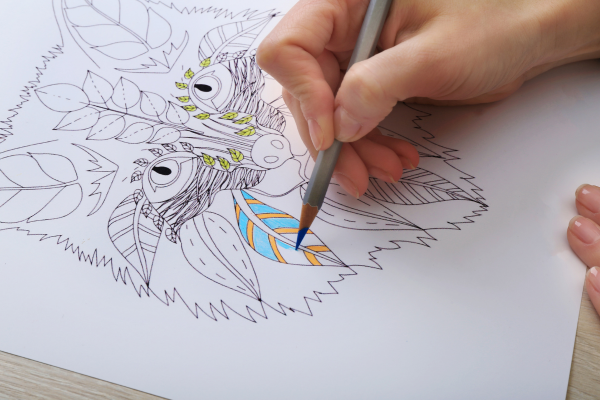
If you’re looking for an activity that college students absolutely love, then check out Adult Coloring Books! This activity is relaxing engaging, making students feel young again.
Throughout my time in college, I had one teacher plan this activity during exam time. She gave the class the option of studying or doing adult coloring, and most students decided to color.
Coloring was an excellent way to wake our minds off of exams, and it was quite therapeutic.
30. Use YouTube For Classroom Activities
YouTube is a great tool for classroom activities. On YouTube, there are plenty of useful resources that can lead to some fantastic class discussions. Throughout my time in college, the professors would use TED Talks to inspire us and to get the class talking.
There are plenty of YouTube videos that encourage students to think outside of the box. Oftentimes, these videos can be very impactful, and they will resonate with them.
31. Collaborative Concept Mapping
Splitting the students into small parties and having them develop a concept map is a great activity that encourages teamwork, critical thinking, and group discussion. Since a concept map requires students to work together, this is a great activity for students to break the ice.
Start by giving the student a blank sheet of paper and giving them a concept. After 10-15 minutes, most groups should be done and ready to share their ideas with the class.
You can end this activity by having the students present their concept map to the class.
32. Crazy Hair Day
When it comes to campus events that get student engagement, Crazy Hair Day always works!
Planning a day where students can come to school with crazy hair is one of the best college event ideas. This activity is great because any student can get involved, it’s easy to plan.
A good way to encourage students to come to school with crazy hair is by making it a competition. Around lunchtime, host an event where students can vote on who has the craziest hair!
This is a great activity for Spirit Week, and it is a fun way to get your fellow students excited about an event.
33. The One-Minute Paper
If you’re looking for a fun activity for college students, consider trying the One-Minute Paper. This fun activity encourages students to think independently and develop their writing skills.
For this activity, you will begin by giving the students a prompt. The students will have one minute to write about the prompt, and then they can either read it to the class or submit it to the teacher.
This is an activity that I did several times throughout college, and I always found it a fun way to build writing skills.
34. Moral Dilemmas

Moral Dilemma is an interactive activity encouraging students to converse and voice their opinions.
For this activity, you create a few groups of students and provide them with an ethical dilemma. Students will then have to think outside the box and come up with a creative solution.
When students are coming up with a solution, they may share their personal experiences, which can lead to some heated discussions. It’s important to monitor the conversations and make sure students are pushing the conversations forward instead of arguing.
35. Movie Day
If you’re looking for an activity that every student loves, planning a movie day is a great idea. These movies can be classics, educational, or relevant to a theme you are trying to cover.
As students, we appreciate a fun activity that doesn’t involve “traditional” school work. Even if it’s a movie that leads to an assignment, college students will appreciate it.
Related & Popular Posts
- Best Backpacks For College Guys – By a Recent Graduate
- Ways to Make Your Teacher Like You in College
- Best Shoes for College Students (for Girls and Guys)
- Ways to Be Happy in College – Advice From a Recent Graduate
- Reasons Why College is Stressful & What You Can Do About it
- College Desk Essentials Every Student Needs
Final Thoughts on 35 Fun Activities For College Students
Getting a classroom full of college students to participate in an activity can be a real challenge. On the bright side, there are plenty of activities that are tons of fun for college students.
As a recent college graduate myself, I can say that all these activities mentioned above are really fun and a great way for students to get to know their classmates and teacher better.
What’s your favorite activity for college students? Please let me know in the comments below.
Ethan Schattauer
3 thoughts on “ 35 Fun Activities for College Students (interactive, team building, games) ”
“I can guarantee that I’m not skipping class if I know there will be food!”…..haaa, truth though….total truth! 😁✌🏼
Crazy Hair Day – oh my gosh, I literally LOL’d when I saw that one! 😂💯
If I were one of the college students, I think my favorite activities would be Kahoot! (love that name), Two Truths and a Lie, the potluck, a bus trip, and definitely those coloring books – crayons, coloring, and drawing are the best!
Mr. Ethan – would love to see a post under lifestyle/miscellaneous where you give your own personal recommendations of some good books to read that are authored by Gen Z’ers.
The minds of Gen Z are….to be perfectly honest here…legendary. I’ve watched several online movies and series that revolve around Gen Z, not to mention witnessing the actual lives of Gen Z’ers that I know in real life, and the mindset with which you guys face this often times crazy world that you were born into is so uniquely smart and respectable. You are a generation that is both futuristic and classic at the same time – as I always say, you rock a bold 80’s vibe with a far superior level of 20’s sophistication.
The thoughts you guys have about life and the world in general are so on point and profound. I have had some of the most brilliantly engaging conversations ever with the 20-something members of your gen, and I would love to find at least one good book that delves even further into the inner mind and perspective of its Gen Z author as they navigate life in the new millennium.
Wow, superb blog layout! How long have you been blogging for? you make blogging look easy. The overall look of your site is magnificent, as well as the content!
Comments are closed.
Recent Posts
7 Styles Of Dress Shoes Every Man Needs
Discovering the perfect pair of dress shoes for a man can often feel like a daunting task. The desire for shoes that are not only visually appealing but also durable and of high quality can sometimes...
10 Dos and Don'ts Every College Student Needs to Know
College is a big step up from high school, and there are some important habits that every student should implement and some habits that every student should avoid. Freshman year will be...
Blog > The 10 best PowerPoint Games to play in Workshops, Classrooms & Presentations
The 10 best PowerPoint Games to play in Workshops, Classrooms & Presentations
01.01.20 • #fun #game #powerpoint #presentation.
In our last blog post, we talked about tools and tips on how to boost the audience engagement in your presentation. One of our recommended ways to do so was to play games, as they release tension and function as a fun element that lightens the mood. That’s why today we are going to list the Top 10 best games to play in your presentation.
1. Would you rather
Is it a game that everyone knows already? Probably. But did we have to include it on the list because it is just perfect for playing with your audience? Definitely. The game is pretty much self-explanatory – You give your attendees two (or more) scenarios and they have to choose which one they’d rather experience. Combining the Would you rather – question with your presentation topic is usually very easy, but we also thought of some questions you could use for any topic (e.g. as an icebreaker, to get to know your audience a little better, to ask about their opinion or just as a fun element in between). You can let your audience vote by letting them raise their hands or by using an interactive poll tool such as SlideLizard .
- Would you rather A. travel back in time OR B. travel to the future OR C. stay in the present
- Would you rather A. have a long lunch break now OR B. have a short break and finish early
- Would you rather A. be able to read minds OR B. be able to fly OR C. be able to turn invisible
- Would you rather A. receive a letter from Hogwarts OR B. join Frodo on his journey OR C. Hog-what?
- Would you rather A. never be able to go on Social Media again B. never be able to read a book again

2. Charades
The popular game is not only great for your family’s game-night, but also for your presentations and workshops. Prepare a few cards that have words related to your presentation’s topic on them, let some volunteers in your audience draw and act them out. The rest of the audience has to guess the word. You can be sure that these terms and the associated performances will never be forgotten!

Small Trivia quizzes are perfect for checking and manifesting the audience’s knowledge at the end of your presentation. Instead of repeating and summing up what you have already said, you can let your participants test their knowledge right away. However, you can also use a quiz in the beginning to test your audience’s existing knowledge about a topic. But there are not only trivia quizzes: Questions about personality can also be interesting and work well as an ice breaker in the beginning. Again, we recommend a tool for poll creation, as that is the easiest way to conduct quizzes. In a recent article we listed 50 great questions (a mix of personality and trivia) , that you could use for your next presentation! And if you're a fan of quiz game shows, we also got a full Who wants to be a Millionaire PowerPoint template for you to download for free! You'll see how it looks like in the following video (be sure to turn up your sound!):
PowerPoint can be used for way more than most people know. Even we were amazed by people on the internet who created extensive games by animating content using PP. We don’t want to go that big today, but we are going to provide you with a free-to-download template of memory. You only have to add it to your presentation and customize the pictures or terms you want under the cards. Download free PPT Memory Template
5. Two Truths and a Lie
Here is another game that is just perfect when you play it with interactive poll tools. It is great for getting the audience to know you as a presenter better. Think of a fun, interesting or astonishing fact about yourself, and then invent two fake ones. Your attendees have to vote which statement they think is true. Be prepared to see some very surprised faces in your audience!

6. PowerPoint Karaoke
PowerPoint-Karaoke is the perfect improvisation game. Players are confronted with a set of slides they have never seen before and try to give a presentation as convincingly as possible. If you want to know all about this game and get some slides you can use for playing, check out our detailed blog post on PowerPoint-Karaoke .

7. Where do you stand?
For the game “Where do you stand?”, your attendees will actually have to stand up. Therefore, it is only convenient if you have enough space. If you want to get your participant’s opinion about something and get them to move a little, look no further! Create an imaginary line across the room. One end stands for one opinion, the other end for the exact opposite opinion. Your attendees can now place themselves on this line wherever they like (right in the middle, on either end or somewhere in between). You can then even interview people on the line (it is always interesting to choose two from opposite sites) and learn about their views. If you’re a little overwhelmed now, here are some examples you could use for this game:
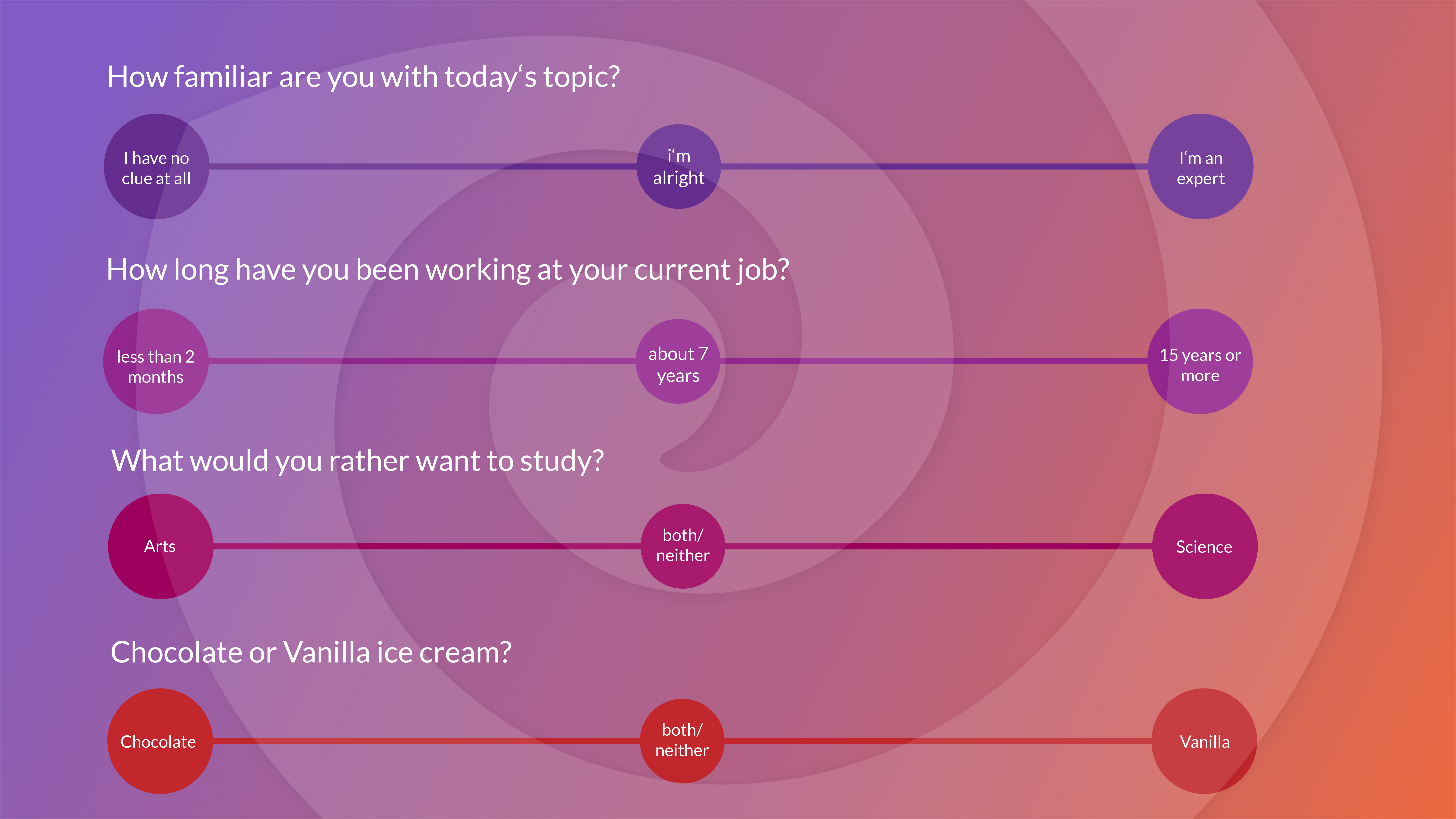
Attention – you can of course ask about political or more controversial topics, but that may escalate and turn into a fight, which is not the purpose of the game or your presentation.
8. Describe That
Let your audience draw from cards with words on them and then describe it for the other attendees. It is basically like charades, but with words instead of acting. Some may find that too easy. In that case, you can either choose terms that are extremely hard to describe or add some “Taboo-words” to the card that can’t be used for describing.

9. True and False
Have you ever heard a crazy, bizarre fact where you didn’t think that it could be true? Perfect. You can use it in the well-known “True and False”-Game. You pick out a fact (ideally something related to your presentation topic) and then let your audience vote (you know – via an interactive poll tool like SlideLizard ) if they think it’s true or not. A tip for making statements false: Change little things about the them, like numbers, dates or names or use common misconceptions and see how many of your attendees buy into them, e.g. “Bulls are enraged by the color red” (which is false, bulls are simply enraged by movement, not specific colors).

10. The never-ending sentence
The never-ending sentence is a great game that incorporates many of your attendees and awakens their brain cells. It is perfect for keeping up their engagement and interest, especially for long presentations or workshops when you feel like some people are getting a little tired. Simply start by saying a word – it can be related to the presentation’s topic if you want – and ask a person in your audience to repeat that word and add another one – the next person to repeat those two words and add another one as well , and so on, until a sentence forms. As it gets longer the game gets a lot more difficult, because there is a lot more to remember and to repeat. The sentence can’t be ended, it has to be continued until someone makes a mistake (or until the last person in the room has added a new word). We promise that you will be left with a lot of fun, creative, and straight-up weird sentences that will make your audience laugh a lot.

Related articles
About the author.

Pia Lehner-Mittermaier
Pia works in Marketing as a graphic designer and writer at SlideLizard. She uses her vivid imagination and creativity to produce good content.

Get 1 Month for free!
Do you want to make your presentations more interactive.
With SlideLizard you can engage your audience with live polls, questions and feedback . Directly within your PowerPoint Presentation. Learn more

Top blog articles More posts
Best Sources for free Icons to use in PowerPoint Presentations

How to highlight image area in PowerPoint

Get started with Live Polls, Q&A and slides
for your PowerPoint Presentations
The big SlideLizard presentation glossary
Visual communication.
If there are used images or videos for communication, it is visual communication. Visual Communication is almost used everywhere like on television, posts on social media (Instagram, Facebook), advertisement.
.odp file extension
.odp files are similar to .ppt files. It's a presentation which was created with Impress and contains slides with images, texts, effects and media.
Vocalized pause
A vocalized pause means the pause when the silence between words is filled by the speaker with vocalizations like "um", "uh" and "er".
Student Response System (SRS)
With Student Response Systems (SRS) it is possible to get live student feedback in the classroom. Questions and answers can usually be asked and given anonymously, which increases participation and engagement. An SRS may be used for any grade, including university.
Be the first to know!
The latest SlideLizard news, articles, and resources, sent straight to your inbox.
- or follow us on -
We use cookies to personalize content and analyze traffic to our website. You can choose to accept only cookies that are necessary for the website to function or to also allow tracking cookies. For more information, please see our privacy policy .
Cookie Settings
Necessary cookies are required for the proper functioning of the website. These cookies ensure basic functionalities and security features of the website.
Analytical cookies are used to understand how visitors interact with the website. These cookies help provide information about the number of visitors, etc.
15 Fun Public Speaking Activities for College Students
Hrideep barot.
- Public Speaking , Toastmasters

Public speaking activities for college students offer invaluable opportunities to develop essential communication skills, boost confidence, and prepare for future academic and professional endeavors. These activities go beyond the traditional classroom setting, providing engaging and interactive platforms for students to refine their public speaking prowess. Whether it’s through exercises that focus on vocal modulation and storytelling or games that encourage friendly competition, these activities empower college students to become more effective and articulate communicators. In this guide, we will explore a variety of public speaking activities and their benefits, offering college students a roadmap to becoming more confident and proficient speakers.
What is Public Speaking?
“Speak in such a way that others love to listen to you. Listen in such a way that others love to speak to you.” – Anonymous
Greetings, fellow wordsmiths and speech enthusiasts! If you’ve ever felt your heart race at the thought of addressing a crowd, or if you’ve found yourself tongue-tied when all eyes are on you, fear not! We’re diving headfirst into the exhilarating world of public speaking, where words wield power, charisma is your secret weapon, and confidence is your trusty sidekick.
In this captivating blog, we’ll unravel the art of public speaking, demystify stage fright, and equip you with the skills to command any room, from a cozy gathering of friends to a roaring auditorium filled with strangers. Get ready to discover the hidden orator within you and embark on a journey that promises not just personal growth but also oodles of fun.
So, whether you’re preparing to ace that next presentation, dazzle at a social event, or simply want to boost your communication prowess, join us on this electrifying adventure. As we explore the ins and outs of public speaking, we’ll throw in some tricks, share tales of triumphs and fumbles, and sprinkle in a dash of humor to make the journey as enlightening as possible.
Can Public Speaking be learned?
Contrary to popular belief, not all great speakers were born with a silver tongue. The majority of captivating orators you admire today started as mere mortals who stumbled over their words and faced their fair share of stage fright. Let’s dive into the fascinating world of public speaking and explore how this skill is cultivated.
The Natural Born Orator: Myth or Reality?
While some individuals possess an innate knack for public speaking from a young age, they are the exception, not the rule. These “natural born orators” are like unicorns in the speaking world, rare and enchanting. They effortlessly command attention, spin mesmerizing tales, and leave audiences hanging on their every word. But here’s the kicker: there are a few of them around!
The Majority: Made, Not Born
The truth is, most of the world’s renowned speakers, from Winston Churchill to Oprah Winfrey, Malcolm X to J.K. Rowling, didn’t emerge from the womb delivering flawless speeches. They developed their skills through dedication, practice, and a willingness to learn from their mistakes.
Consider this: according to studies, around 75% of people suffer from glossophobia , which is the fear of public speaking. This statistic alone should reassure you that you’re not alone in your struggles. Even some of the greatest public speakers initially grappled with stage fright and stumbled through their early speeches.
The Power of Learning and Practice
So, how do these once-timid souls transform into magnetic orators? They embrace the art of public speaking as a craft that can be cultivated by immersing themselves in the intricacies of effective communication, learning about body language, voice modulation, and the art of storytelling. They attend workshops, take public speaking courses, and practice their skills relentlessly.
Moreover, they aren’t afraid to learn from their missteps. Every “um” and “uh,” every moment of nervousness, is seen as an opportunity for improvement. They analyze their performances, seek feedback, and refine their technique. The bottom line is this: public speaking is a skill, not a genetic trait. With the right mindset, determination, and a bit of guidance, anyone can become a masterful speaker.
Best Public Speaking Activities for college students:
A) public speaking games for college students.
Public speaking games are interactive and engaging activities designed to improve public speaking skills, boost confidence, and enhance communication abilities. Games are interactive and often competitive, making learning more engaging and enjoyable. Here are some examples of public speaking games:
- 30 Second Speech
- Just A Minute Speech
- Debate Duels
- Storytelling Relay
- Public Speaking Bingo
- Speech Speed Dating
- Public Speaking Charades
- Speech Olympics
- Role Reversal
1. 30-second speech
What is the 30-second speech activity? Performing a 30-second speech in a classroom setting is a concise yet impactful way to communicate your ideas or present information. This activity typically involves standing in front of your classmates or audience and speaking for exactly 30 seconds on a chosen topic. The goal is to effectively convey your message within this short time frame while engaging your audience and leaving a lasting impression.
- Introduction (5-7 seconds): Begin with an engaging opener, stating your topic’s relevance.
- Main Message (15-18 seconds): Convey your core point concisely with supporting evidence.
- Conclusion (5-7 seconds): Summarize or issue a call to action to reinforce your message.
Rules and Tips:
- Manage time closely.
- Speak clearly and at a steady pace.
- Engage the audience with questions or prompts.
- Use confident body language.
- Utilize visual aids if allowed.
- Stay calm by practicing and taking deep breaths.
By adhering to these steps and guidelines, you can confidently deliver a compelling 30-second speech in class.
2. Just A Minute speech (JAM)
What is the Just A Minute speech activity? The “Just A Minute” ( JAM ) speech activity challenges participants to speak on a given topic for one minute without hesitation, repetition, or deviation. It fosters improvisational speaking skills and quick thinking.
Preparation:
- Topic Familiarization: Stay informed about various topics.
- Practice: Hone spontaneous speaking abilities on diverse subjects.
How to Do It:
- Selection: Participants are chosen randomly or in order.
- Topic Assignment: A moderator provides a topic, and the speaker has one minute to discuss it.
- Rules: Avoid hesitation, repetition, or deviation from the topic.
- Scoring: Judges evaluate adherence to rules, fluency, and content quality.
- The JAM speech activity is an enjoyable and educational exercise for enhancing public speaking and improvisation skills.
3. Debate Duels:
Activity: Debate duels involve organizing structured debates between two students or teams who argue opposing sides of a chosen topic. Participants present arguments, offer rebuttals, and conclude their case. The goal is to foster well-researched arguments and promote respectful discourse.
- Topic Selection: Choose a relevant and debatable topic.
- Research: Participants should research their respective positions thoroughly.
- Format: Decide on debate format (e.g., timed speeches, cross-examination).
- Roles: Assign roles such as debaters, moderators, and timekeepers.
- Opening Statements: Each side presents its arguments.
- Rebuttals: Teams respond to opponents’ arguments.
- Cross-examination (if included): Teams question each other.
- Conclusions: Summarize key points and restate positions.
- Maintain respect and civility.
- Use evidence and logic to support arguments.
- Stick to time limits for speeches.
- Follow the predetermined format.
Debate duels provide a platform for students to develop research, critical thinking, and communication skills through structured, respectful debate.
4. Storytelling Relay:
Activity: In a storytelling relay, teams of 3-4 students collaborate to create a narrative. It starts with one student providing an opening sentence, and each subsequent student adds one sentence to continue the story. The aim is to build a cohesive narrative with seamless transitions.
- Team Formation: Divide students into teams of 3-4 members.
- Topic or Theme: Decide if there’s a specific topic or theme for the stories.
- Order: Determine the order in which students will contribute to the story.
- Time Limit: Set a time limit for each sentence contribution, e.g., 10 seconds.
- Opening Sentence: The first student in each team provides an opening sentence to begin the story.
- Sentence Contributions: Each student takes turns adding one sentence to continue the narrative.
- Transitions: Students must ensure their sentences connect smoothly with the previous ones.
- Cohesion: Teams collaborate to maintain consistency and coherence in the story.
- Maintain the predetermined order for sentence contributions.
- Keep sentences concise and on-topic.
- Ensure sentences flow logically from one another.
- Encourage creativity and adaptability.
Storytelling relay is a creative and collaborative activity that fosters teamwork, creativity, and improvisation skills as students work together to build a compelling story.
5. Public Speaking Bingo:
Activity: In Public Speaking Bingo, bingo cards with different public speaking challenges in each square are created (e.g., “Use a compelling statistic,” “Maintain eye contact,” “No filler words”). During speeches, students mark off squares as they complete the challenges, aiming to achieve a bingo.
- Bingo Cards: Create bingo cards with various public speaking challenges randomly placed in each square.
- Topics: Prepare speech topics or allow students to choose their own.
- Markers or Chips: Provide markers or chips for students to use when they complete a challenge.
- Prizes (optional): Consider offering small prizes for students who achieve bingo.
- Card Distribution: Distribute the bingo cards to students before the speeches begin.
- Speeches: As students give their speeches, they mark off squares when they complete the challenges listed.
- Winning: The first student to complete a row, column, or diagonal with marked squares shouts “Bingo!” and wins the game.
- Challenges must be completed during the speech.
- Challenges should be marked off honestly.
- The winner should declare “Bingo” immediately upon completing a line of challenges.
Public Speaking Bingo is a fun and interactive activity that encourages students to focus on specific public speaking skills and techniques while delivering speeches, making the learning experience engaging and enjoyable.
6. Speech Speed Dating:
Activity: Speech Speed Dating involves pairing students and giving them 3-5 minutes each to introduce themselves or present a mini-topic. After each “date,” students switch partners. This exercise helps improve speaking under time constraints and fosters active listening skills.
- Pairing: Arrange students in pairs.
- Topics (optional): Prepare mini-topics or allow students to choose what they’ll speak about.
- Timer: Set a timer for each speaking session.
- Space: Ensure there’s enough space for students to move between partners.
- Introduction: Students introduce themselves or present their mini-topic to their partner within the time limit.
- Switch Partners: After the allotted time, students rotate to a new partner and repeat the process.
- Repeat: Continue this cycle for multiple rounds, allowing students to interact with different partners.
- Stick to the time limit for each speaking session.
- Encourage active listening and engagement during each “date.”
- Ensure students switch partners as instructed to maximize interaction.
Speech Speed Dating is a dynamic activity that enhances students’ ability to convey information succinctly and promotes effective listening and engagement in a fast-paced speaking environment.
7. Public Speaking Charades:
Activity: Public Speaking Charades involves creating cards with different public speaking scenarios or gestures (e.g., “Giving a TED Talk,” “Delivering bad news”). Students act out these scenarios without speaking, and the audience guesses what they’re portraying. This exercise enhances nonverbal communication skills.
- Scenario Cards: Prepare cards with various public speaking scenarios or gestures.
- Audience: Arrange for an audience or divide students into small groups to take turns acting and guessing.
- Timer: Set a timer for each acting session.
- Card Draw: One student draws a scenario card and acts it out without speaking.
- Guessing: The audience or other students guess what public speaking scenario is being portrayed.
- Rotation: After a set time or when the correct guess is made, a new student takes a turn.
- No speaking or verbal cues are allowed during the charades.
- Encourage creative and expressive gestures to convey the scenario.
- Keep the game moving by setting time limits for each turn.
Public Speaking Charades is a lively activity that sharpens nonverbal communication skills and creativity while making public speaking scenarios more engaging and memorable.
8. Speech Olympics:
Activity: Speech Olympics is a structured competition where students participate in a series of public speaking challenges, which can include tongue twisters, impromptu storytelling, persuasive pitches, and more. Participants earn medals or points based on their performance. This activity provides a fun and lighthearted way to develop various speaking skills.
- Challenge Selection: Choose a variety of speaking challenges that suit the skill levels of the participants.
- Scoring System: Determine how participants will earn points or medals (e.g., judging panels or audience voting).
- Materials: Prepare any necessary materials or props for specific challenges.
- Medals or Prizes: Optional – acquire medals or prizes for winners.
- Introduction: Explain the rules and challenges to the participants.
- Challenge Rotation: Participants move through a series of challenges, competing against each other.
- Scoring: Use the predetermined scoring system to assess performance and award medals or points.
- Winners: Announce the winners and celebrate their achievements.
- Participants must adhere to the specific rules of each challenge.
- Judges or the audience score performances based on predefined criteria.
- Encourage sportsmanship and respectful competition.
Speech Olympics is a dynamic activity that allows students to practice a range of speaking skills competitively and engagingly, making it an enjoyable learning experience.
9. Role Reversal:
Activity: In Role Reversal, students play both the role of the speaker and the audience. After delivering a speech, they switch roles, with the audience members providing constructive feedback to the speaker. This exercise helps students gain insight into the audience’s perspective and fosters effective feedback skills.
- Speech Topics: Assign or allow students to choose their speech topics.
- Feedback Guidelines: Prepare guidelines for constructive feedback.
- Peer Evaluation Forms: Create forms or worksheets for audience members to provide feedback.
- Speaker’s Turn: A student delivers a speech on their chosen topic.
- Role Reversal: After the speech, the roles switch, and the audience becomes the feedback provider.
- Feedback Session: The audience offers constructive feedback, focusing on strengths and areas for improvement.
- Discussion: Encourage a brief discussion where the speaker can ask clarifying questions or provide context for their choices.
- Feedback should be respectful and constructive, focusing on the speech’s content and delivery.
- Encourage active listening and thoughtful feedback from the audience.
- The speaker should be receptive to feedback and open to improvement suggestions.
Role Reversal is an interactive exercise that enhances students’ understanding of both the speaker and audience perspectives, promoting effective communication skills and constructive feedback within a learning environment.
B) Public Speaking Exercises for college students:
Public speaking exercises are structured activities and practices aimed at improving public speaking skills. Exercises are structured activities that often focus on specific aspects of public speaking, such as breath control, diction, or body language. Each exercise typically targets a specific aspect of public speaking or communication. Here are some common public speaking exercises:
- Breathing Exercises
- Tongue Twisters
- Mirror Practice
- Storytelling Practice
- Impromptu Practice
- Emotional Vocal Modulation
1. Breathing Exercises
Diaphragmatic breathing is a technique that involves using your diaphragm, a muscle located below your ribcage, to control your breath. It is a fundamental exercise for improving vocal projection and managing anxiety during speaking or public speaking situations.
How to Do It: To perform diaphragmatic breathing, sit or stand comfortably with proper posture. Inhale deeply through your nose for a slow count of four, allowing your diaphragm to expand and your lower lungs to fill. Hold your breath for four counts without tensing your chest or neck. Then, exhale slowly and steadily through your mouth for another count of four. Repeat this breathing pattern regularly to strengthen your diaphragm, enhance vocal projection, and reduce anxiety associated with speaking engagements.
2. Tongue Twisters:
Tongue twisters are word or phrase sequences designed to be challenging to articulate due to their repetitive or tricky sounds. This exercise is used to improve pronunciation, diction, and speech clarity.
How to Do It: To perform tongue twisters, start with simple ones and gradually advance to more complex ones as your proficiency grows. Pronounce each word or phrase, emphasizing correct articulation, and gradually increase your speed. The goal is to challenge your tongue and mouth muscles, enhancing your ability to enunciate words clearly and improving your overall speech clarity.
- She sells seashells by the seashore.
- Fuzzy Wuzzy was a bear; Fuzzy Wuzzy had no hair. Fuzzy Wuzzy wasn’t very fuzzy, was he?
- How can a clam cram in a clean cream can?
- Unique New York, you know you need a unique New York.
- Red leather, yellow leather.
- Six slippery snails slid slowly seaward.
- Betty Botter bought some butter but the butter was bitter, so Betty bought some better butter to make the bitter butter better.
- Peter Piper picked a peck of pickled peppers. How many pickled peppers did Peter Piper pick?
- Irish wristwatch, Swiss wristwatch.
3. Mirror Practice:
Mirror practice is a technique used to enhance your public speaking skills. It involves standing in front of a full-length mirror while delivering a speech or presentation. The aim is to closely observe and improve your body language, facial expressions, and gestures as you speak.
How to Do It: To perform mirror practice, position yourself in front of a full-length mirror, ensuring you have a clear view of yourself. Deliver your speech or presentation as you normally would, paying keen attention to your reflection. Focus on your posture, hand movements, facial expressions, and any other nonverbal cues you use while speaking. By actively observing yourself in the mirror, you can identify areas for improvement in your delivery and work on refining your public speaking skills over time.
4. Storytelling Practice:
Storytelling practice involves sharing personal anecdotes or stories with friends or peers while incorporating storytelling techniques such as creating suspense, infusing humor, and using vivid descriptions. This practice is aimed at refining your storytelling skills and making your narratives more engaging.
How to Do It: To perform storytelling practice, select a personal anecdote or story you’d like to share. As you share it with friends or peers, focus on the storytelling elements. Create suspense by building anticipation and keeping your audience curious about what happens next. Infuse humor by adding funny anecdotes or witty remarks where appropriate. Use vivid descriptions to paint a clear picture and evoke emotions. By practicing storytelling in this way, you can develop your ability to captivate your audience and make your narratives more compelling.
5. Impromptu Topics:
Impromptu topics practice involves regularly engaging in impromptu speaking by selecting random topics or prompts and delivering short, on-the-spot speeches about them. This exercise is designed to sharpen your ability to think quickly and articulate ideas effectively without prior preparation.
How to Do It: To perform impromptu topic practice, have a selection of random topics or prompts ready. These topics can be related to various subjects, such as current events, personal experiences, or hypothetical scenarios. Choose a topic at random and challenge yourself to deliver a brief speech or response to it without any prior planning or research. This exercise will help you become more comfortable with spontaneous speaking, improve your ability to organize your thoughts quickly and enhance your overall communication skills.
6. Emotional Vocal Modulation:
Emotional vocal modulation is a technique used to enhance the expressiveness of your speeches. It involves practicing the variation of your tone, pitch, and inflection to convey different emotions effectively. By modulating your voice, you can captivate your audience and convey a range of feelings and sentiments in your presentations.
How to Do It: To perform emotional vocal modulation, start by selecting a piece of text or speech. As you practice, deliberately vary your tone, pitch, and inflection to match the emotions or sentiments you want to convey. Experiment with different vocal techniques, such as using a higher pitch for excitement, a lower pitch for seriousness, or fluctuating tone for emphasis and engagement. Regular practice of emotional vocal modulation will help you become a more dynamic and compelling speaker, capable of engaging your audience on an emotional level.
Where to start Public Speaking?
Starting on the path of public speaking as a college student is a wise decision that can have a significant impact on your academic and professional life. Here’s a step-by-step guide to help you get started:
1. College Public Speaking Courses:
College public speaking courses are an excellent starting point for students eager to develop their speaking skills. These courses typically provide a structured and comprehensive approach to public speaking. You’ll learn about speech organization, effective delivery techniques, and strategies to engage your audience. Instructors are often experienced public speakers who can offer valuable insights and feedback.
Additionally, these courses offer a supportive environment for practicing your speaking skills. You’ll have the opportunity to present speeches in front of your peers, receive constructive criticism, and refine your abilities. As a bonus, college courses often provide resources like textbooks and access to speech labs to help you master the art of public speaking.
“The best way to conquer stage fright is to know what you’re talking about.” — Michael H. Mescon
2. Join Public Speaking Clubs:
Toastmasters and similar public speaking clubs are renowned for their ability to transform nervous speakers into confident orators. These clubs provide a supportive community of individuals who share a common goal: improving their public speaking skills. They offer a structured framework where you can gradually work your way up from short impromptu speeches to longer prepared presentations.
What makes these clubs invaluable is the frequent practice opportunities they provide. You can refine your skills in a nonjudgmental environment, receive feedback, and witness the progress of fellow members. Joining such a club can be a powerful stepping stone in your public speaking journey.
Toastmasters International has over 364,000 members in 16,200 clubs in 145 countries.
You can join our online community of Toastmasters for engaging in Learning and Group Discussions here.
3. Online Public Speaking Resources:
In today’s digital age, a wealth of online resources is readily available to aid in your public speaking education. You can find books, articles, videos, and courses dedicated to the subject. These resources cover a wide range of topics, from speech preparation and delivery techniques to managing stage fright.
The advantage of online resources is their accessibility and flexibility. You can explore these materials at your own pace, focusing on areas that need improvement. Whether you’re looking for expert advice, speech templates, or video tutorials, the internet offers a vast repository of knowledge to help you become a more effective speaker.
Over 3,000 books on public speaking are available on Amazon.
4. Self-Practice and Recording:
Self-practice is a fundamental component of improving your public speaking skills. Whether it’s practicing in front of a mirror, recording your speeches, or rehearsing in an empty room, these exercises help you become more comfortable with your own voice and body language.
Recording yourself is particularly valuable as it allows you to objectively assess your performance. You can analyze aspects like tone, gestures, and clarity of speech. By identifying areas that need refinement, you can tailor your practice sessions to address specific weaknesses and gradually build confidence.
“Practice puts brains in your muscles.” — Sam Snead
5. Seek Feedback from Professors and Peers:
Constructive feedback is an essential component of growth as a speaker. Don’t hesitate to reach out to professors and peers for input on your presentations. Professors, with their expertise, can offer valuable insights into your content, organization, and delivery.
Additionally, peers can provide a different perspective and offer suggestions for improvement. Collaborative learning and sharing feedback within your academic community can enhance your speaking skills and help you gain a fresh outlook on your strengths and weaknesses as a speaker.
In a survey, 94% of employees said they’d benefit from feedback, according to Harvard Business Review.
6. Volunteer for Speaking Opportunities:
Volunteering to speak in class or participate in campus events is a practical way to apply what you’ve learned. These opportunities allow you to gain real-life experience, helping you overcome nerves and improve your ability to connect with an audience.
Whether it’s delivering a presentation in front of your classmates or addressing a larger crowd at a campus event, each experience contributes to your growth as a speaker. The more you put yourself in these situations, the more confident and adept you’ll become at conveying your message effectively.
Example: Delivering a class presentation on a topic you’re passionate about.
7. Study Renowned Speakers:
Studying the speeches of renowned public speakers is a powerful way to improve your skills. Analyzing speeches from figures like Martin Luther King Jr., Winston Churchill, Oprah Winfrey, or TED Talk presenters can provide valuable insights into effective rhetoric, storytelling, and engagement techniques.
By dissecting these speeches, you can learn how to structure your content, use persuasive language, and capture your audience’s attention. It’s a practical way to see proven strategies in action and apply them to your presentations.
Example: Analyzing Martin Luther King Jr.’s “I Have a Dream” speech for rhetorical techniques.
These seven options offer a diverse range of opportunities for college students to embark on their journey toward becoming effective public speakers. Whether you choose formal education, community support, online resources, or practical experience, remember that the key to success is consistent practice and a commitment to personal growth. Developing your public speaking skills will not only benefit your academic pursuits but also prepare you for future personal and professional endeavors.
Conclusion:
The world of public speaking holds endless possibilities for college students. It’s a realm where your voice, ideas, and stories can resonate and inspire. While the journey to becoming a confident and skilled speaker may seem daunting, the key is to remember that every great orator, from the classroom to the TED stage, started somewhere.
The most crucial step is to just start. Put yourself out there, embrace the challenges, and dive into public speaking activities and exercises. As you navigate tongue twisters, engage in debate duels, or share personal anecdotes, you’re not only honing your communication skills but also building the confidence needed to succeed in academia and the professional world.
Don’t let fear or self-doubt hold you back. The first step may be the most challenging, but it’s also the most transformative. So, seize every opportunity, participate in these activities with enthusiasm, and let your voice be heard. With each word you speak and every audience you engage, you’re inching closer to becoming the confident, influential speaker you aspire to be. Start now, and watch as your public speaking journey unfolds, revealing the remarkable communicator within you.
To seek professional guidance and mentorship for public speaking or Toastmasters, you can reach out to us over here .
Enroll in our transformative 1:1 Coaching Program
Schedule a call with our expert communication coach to know if this program would be the right fit for you

Lost Voice? Here’s How to Recover Sore Throat and Speak Again

7 Keys to Emcee Like a Pro: Unlock Your Hosting Potential

8 Ways to Rise Above the Noise to Communicate Better

- [email protected]
- +91 98203 57888
Get our latest tips and tricks in your inbox always
Copyright © 2023 Frantically Speaking All rights reserved
Kindly drop your contact details so that we can arrange call back
Select Country Afghanistan Albania Algeria AmericanSamoa Andorra Angola Anguilla Antigua and Barbuda Argentina Armenia Aruba Australia Austria Azerbaijan Bahamas Bahrain Bangladesh Barbados Belarus Belgium Belize Benin Bermuda Bhutan Bosnia and Herzegovina Botswana Brazil British Indian Ocean Territory Bulgaria Burkina Faso Burundi Cambodia Cameroon Canada Cape Verde Cayman Islands Central African Republic Chad Chile China Christmas Island Colombia Comoros Congo Cook Islands Costa Rica Croatia Cuba Cyprus Czech Republic Denmark Djibouti Dominica Dominican Republic Ecuador Egypt El Salvador Equatorial Guinea Eritrea Estonia Ethiopia Faroe Islands Fiji Finland France French Guiana French Polynesia Gabon Gambia Georgia Germany Ghana Gibraltar Greece Greenland Grenada Guadeloupe Guam Guatemala Guinea Guinea-Bissau Guyana Haiti Honduras Hungary Iceland India Indonesia Iraq Ireland Israel Italy Jamaica Japan Jordan Kazakhstan Kenya Kiribati Kuwait Kyrgyzstan Latvia Lebanon Lesotho Liberia Liechtenstein Lithuania Luxembourg Madagascar Malawi Malaysia Maldives Mali Malta Marshall Islands Martinique Mauritania Mauritius Mayotte Mexico Monaco Mongolia Montenegro Montserrat Morocco Myanmar Namibia Nauru Nepal Netherlands Netherlands Antilles New Caledonia New Zealand Nicaragua Niger Nigeria Niue Norfolk Island Northern Mariana Islands Norway Oman Pakistan Palau Panama Papua New Guinea Paraguay Peru Philippines Poland Portugal Puerto Rico Qatar Romania Rwanda Samoa San Marino Saudi Arabia Senegal Serbia Seychelles Sierra Leone Singapore Slovakia Slovenia Solomon Islands South Africa South Georgia and the South Sandwich Islands Spain Sri Lanka Sudan Suriname Swaziland Sweden Switzerland Tajikistan Thailand Togo Tokelau Tonga Trinidad and Tobago Tunisia Turkey Turkmenistan Turks and Caicos Islands Tuvalu Uganda Ukraine United Arab Emirates United Kingdom United States Uruguay Uzbekistan Vanuatu Wallis and Futuna Yemen Zambia Zimbabwe land Islands Antarctica Bolivia, Plurinational State of Brunei Darussalam Cocos (Keeling) Islands Congo, The Democratic Republic of the Cote d'Ivoire Falkland Islands (Malvinas) Guernsey Holy See (Vatican City State) Hong Kong Iran, Islamic Republic of Isle of Man Jersey Korea, Democratic People's Republic of Korea, Republic of Lao People's Democratic Republic Libyan Arab Jamahiriya Macao Macedonia, The Former Yugoslav Republic of Micronesia, Federated States of Moldova, Republic of Mozambique Palestinian Territory, Occupied Pitcairn Réunion Russia Saint Barthélemy Saint Helena, Ascension and Tristan Da Cunha Saint Kitts and Nevis Saint Lucia Saint Martin Saint Pierre and Miquelon Saint Vincent and the Grenadines Sao Tome and Principe Somalia Svalbard and Jan Mayen Syrian Arab Republic Taiwan, Province of China Tanzania, United Republic of Timor-Leste Venezuela, Bolivarian Republic of Viet Nam Virgin Islands, British Virgin Islands, U.S.

25% OFF ALL FRAMES OFFER ENDING SOON PROMO CODE: GRAD25
Enter GRAD25 to get 25% OFF
Start Building My Frame
Suggestions:
- Try fewer words; use "Jefferson" instead of "Jefferson High School" or "Thomas" instead of "St. Thomas".
- If you are still not able to find your school or group, please contact Customer Service .
Please note : If your school or group has closed, you will not be able to locate it on our website.

2/28/2024 By University Frames
- 10 Effective Class Presentation Tips for College Students
Giving a presentation to your classmates can be a bit challenging, especially if you are new to visual or oral presentations or fear public speaking.
However, class presentations foster an excellent opportunity for students to enhance their public speaking skills while broadening their perception and understanding of a particular subject matter.
Also, the presentation provides a platform for students to connect with peers, professionals, and potential employers.
By showcasing their skills and knowledge, they can build relationships and establish themselves as a better performer in their field.
While presentation helps students to expand their horizons of knowledge and skills, beginners may be slightly concerned about where to start and how to master it.
Worry not! Here, we discuss the best presentation tips for students for a flawless delivery of the subject.
10 Handy Presentation Tips for College Students
Effective delivery of a presentation requires efficient presentation techniques and exceptional presentation abilities.
The following tips for presenting in class help students strengthen their public speaking skills, empowering them to effectively communicate their message or information to the audience.
1. Overcome Presentation Anxiety
While it is quite common to feel anxious before the presentation, it won’t allow you to deliver a presentation confidently.
There are several reasons why students fear public speaking, including, worrying about committing a mistake, lack of experience, losing control, or what if their audience dislikes their speech.
Nevertheless, don’t worry, as you can overcome your presentation anxieties with the following techniques:
- Prepare and practice your topic thoroughly.
- Just focus on the message you want to convey to your audience.
- Be open to feedback and criticism from others.
- Have a mindset that you are going to make it.
- Practice deep breathing to keep your mind calm and composed.
2. Learn the Art of Public Speaking
Learning and getting used to public speaking can help students feel more confident and comfortable in delivering their message to the audience.
Also, it helps them to structure their thoughts and use perfect language to convey their content crisp and clean while engaging their audience.
There are several ways for students to learn public speaking skills, including:
- Online platforms and courses
- Local resources (community clubs, associations, etc.)
- Public speaking workshops
- Watching experienced public speakers and observing their techniques
Also Read: 17 Best Advice for College Students from Experts .
3. Craft Compelling Content
A robust opening statement sets the tone for the entire student presentation, helping you grab your audience’s attention.
Ensure to develop a clear, concise, and thoughtful opening statement that talks about what the presentation is about and how it helps everyone out there.
Moving on, your body content is the heart of your presentation, and that is what is going to keep your audience in the loop while conveying your ideas and thoughts.
So, it should be well-structured, engaging, and easy to follow. Here’s how you can devise engaging content:
- Create a strong opening and ending statement with a powerful quote, thought-provoking question, or intriguing scenario.
- Clearly and precisely define your topic and its significance.
- Conduct in-depth research that is backed with statistical data or real-time stories.
- Organize your content with slides and images.
4. Add Engaging Visuals
Rather than constantly scrolling the loads of information, it is better to use visuals to engage your audience while helping them comprehend and retain complex matters and building emotional connections with them.
Tips for slideshow presentations:
- Use simple yet high-quality images.
- Add contrast and pleasing colors to make your slides look good.
- Incorporate snippets to support your visuals.
- Keep your slides consistent in terms of layout and design.
- Choose easy-to-follow fonts and numbers.
- Add data, icons, and infographics for illustration.
5. Balance Information and Entertainment
Adding humor to a presentation is a way to engage and connect with your audience more personally.
It can help relieve tension, break the silence/drowsy state of mind, and make complex or dry information more perceivable during class presentation.
Also, it helps keep your presentation memorable for a long time. Here is how you can add humor to your presentation:
- Know your audience and tailor your humor accordingly.
- Use humorous analogies, cartoons, catchphrases, or your own experiences.
- Try not to hurt others while using humor.
- You can make fun of everyday situations or activities, so people can relate with them.
6. Time Management in Class Presentation
Time management is one of the best tips for presenting in class. Starting and finishing your presentation in a predefined time frame is important.
It helps you to convey your message precisely and effectively without disrupting the flow of the presentation and making it difficult for the audience to follow along.
To manage your class presentation time, here are some presentation tips for students:
- Practice beforehand to know the required time.
- If you are going beyond the allotted time, cut short your content, delivering the most important points.
- Use visuals to quickly deliver messages.
- Use a timer to know that you are nearing the end.
7. Real-Life Examples
Listening to successful presentations helps you learn new techniques and gain insights on how to give better presentations. You can take note of key elements used, gestures followed, and eye contact made.
Also, you can study the agenda of the presentation, like how it is structured, what topics are discussed, how properly visuals and icons are used, etc.
Besides, you can pay attention to the language and tonality of the speaker to see how they used humor, stories, and emotional phrases to connect with audiences.
Considering these insights, you can prepare your topic and present it flawlessly.
8. Take Peer Review and Feedback
Feedback is a way to learn where you lag and how you can improve further to build your credibility, professional knowledge and image.
By receiving feedback from peers, you can identify blind spots, fragile areas, and how your content is perceived by others, enabling you to refine your work, address weaknesses, and develop new skills.
Moreover, this presentation tip can strengthen your relationships with your peers while helping you present better every time.
Also Read: Tips for Building Professional Relationships in College .
9. Stay Elegant and Attractive with Your Attire
What you wear and how you wear it matters when it comes to presenting in front of the public.
The clothes you wear can greatly impact how your audience perceives you and your message. So, ensure to present yourself properly and professionally to attract your audience.
Here is how to dress up for class presentations:
- Keep your outfits simple, comfortable, and elegant.
- Avoid flashy colors and designs.
- Choose outfits according to the environment and temperature.
- Get your outfits properly stitched with the right fit.
- Choose the right and soothing footwear.
10. Post-Presentation Reflection
Reviewing your past presentations can help drag strengths and areas for growth, which can help you make informed decisions and optimize your performance.
For example, by analyzing your performance, you can assess what works well and what doesn't. This involves identifying areas for improvement concerning the use of visuals, snippets, icons, infographics, etc.
Knowing these can help you make targeted improvements to enhance your future presentations.
Wrapping Up
A successful class presentation in college is vital for students’ academic and professional journey.
It helps students develop valuable skills that will serve them in their future careers and provides them with an opportunity to showcase their knowledge and ideas to a wider audience.
By mastering the art of presentation, students can set themselves apart from their peers and position themselves for success in their chosen careers.
So, use the above-mentioned presentation tips for students to speak more confidently, sharing your thoughts and ideas.

University Frames
Subscribe to our blog.
Enter your email address:
Latest Offers

Latest Posts
- 8 Trending Diploma Frames for Enhancing Your Space with Style
- 39 Trending Graduation Cap Ideas in 2024
- March Madness Sale: Save Big and Get 20% Off at University Frames
- Get Your Game On with University Frames this March Madness!
Category: College Life Hack
Tags: Class Presentation Tips Class Presentation Tips for College Students college tips presentation tips
- Skip to main content
- Skip to primary sidebar
- Skip to footer
- QuestionPro

- Solutions Industries Gaming Automotive Sports and events Education Government Travel & Hospitality Financial Services Healthcare Cannabis Technology Use Case NPS+ Communities Audience Contactless surveys Mobile LivePolls Member Experience GDPR Positive People Science 360 Feedback Surveys
- Resources Blog eBooks Survey Templates Case Studies Training Help center
Home LivePolls
15 Interactive Presentation Games to Engage Your Audience
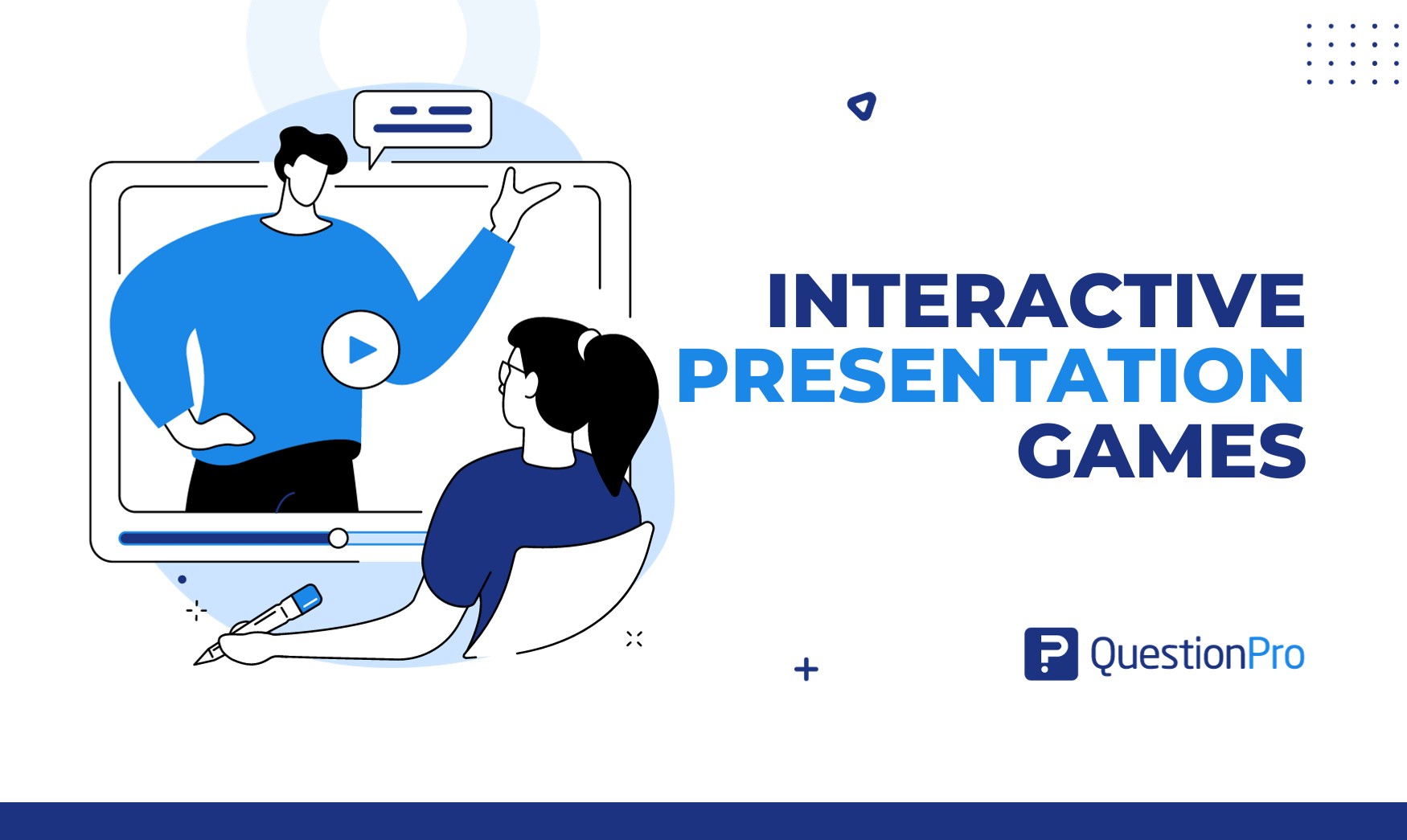
In the world of presentations and public speaking, engaging your audience is crucial. A captivating presentation can leave a lasting impact and ensure that your message is heard and retained. One effective way to achieve this engagement is by incorporating interactive presentation games into your talks.
Interactive presentation games break the monotony of traditional slideshows and transform passive listeners into active participants. In this blog, we’ll explore 15 interactive presentation games that can make your presentations more dynamic, memorable, and enjoyable for your audience.
Why Use Interactive Presentation Games?
Traditional presentations often involve passive listening, which can lead to disengagement and limited retention of information. On the other hand, interactive presentation games create an environment of active participation.
Making your presentations more memorable and impactful. They foster interaction, feedback, and collaboration, turning your audience into active participants rather than passive observers.
Benefits of Engaging Your Audience
Engaging your audience with interactive presentation games offers numerous benefits:
- Increased Engagement: Interactive presentation games grab your audience’s attention and keep them actively involved throughout the presentation.
- Improved Information Retention: Active participation enhances the retention of key information, ensuring that your message sticks with your audience long after the presentation is over.
- Enhanced Learning: Games encourage a deeper understanding of the subject matter, making it easier for your audience to grasp complex concepts.
- Better Audience Connection: By involving your audience, you establish a stronger connection, making them feel valued and heard.
- Immediate Feedback: Games provide opportunities for instant feedback, allowing you to address questions and concerns in real time.
- Fun and Entertainment: Interactive fun games add an element of fun and entertainment to your presentations, making them more enjoyable for your audience.
How to Choose the Right Presentation Games
Selecting the appropriate presentation games depends on your audience, topic, and objectives. Consider factors such as the size of your audience, the level of interactivity you desire, and the technology available. Tailor your choice of games to align with your presentation goals, ensuring they enhance your message rather than distract from it.
Now, let’s explore 15 interactive presentation games that you can incorporate into your presentations to engage your audience effectively:
01. Polling and Surveys
Polling and surveys involve asking questions to your audience and collecting their responses in real time. This game is useful for engaging the audience and gathering valuable data or opinions.
Example: During a marketing presentation, you can use polling to ask the audience which social media platform they use most frequently for product discovery, with response options like “Facebook,” “Instagram,” or “Twitter.” The results can guide your marketing strategy.
02. Quiz and Trivia
Quiz and trivia games challenge the audience’s knowledge of a specific subject. Correct-answer questions encourage competition and learning because participants’ scores are added up.
Example: In a history lecture, you can organize a trivia quiz about historical events. Ask questions like, “Who was the first President of the United States?” and award points for correct answers to make learning history engaging.
03. Interactive Q&A Sessions
Interactive Q&A sessions allow the audience to ask questions and engage in a live dialogue with the presenter. This interactive presentation game promotes engagement, clarification, and in-depth discussions.
Example: After a business strategy presentation, open the floor for an interactive Q&A session where the audience can ask questions about the proposed strategies, fostering a deeper understanding of the material.
04. Gamified Scenarios
Gamified scenarios present real-world situations or challenges to the audience. Participants make decisions, and the consequences of those choices are revealed, creating an immersive learning experience.
Example: In leadership training, simulate a business scenario where participants make decisions as managers. Their choices affect the company’s success, making the learning process engaging and interactive.
05. Virtual Reality and Augmented Reality Experiences
Virtual reality (VR) and augmented reality (AR) games provide immersive 3D experiences. Participants can explore virtual environments or interact with augmented elements.
Example: In a product launch presentation, use AR to allow the audience to visualize how the product would fit into their homes. They can use their smartphones to see a virtual presentation version of the product in their living rooms.
06. Storytelling Challenges
Storytelling challenges encourage participants to create and share their stories, fostering creativity and personal expression.
Example: In a team-building workshop, ask each participant to share a personal success story related to teamwork. This engages the audience and builds a sense of connection among participants.
07. Collaborative Whiteboard Activities
In real-time, collaborative whiteboard activities involve multiple participants contributing ideas, drawings, or annotations on a digital whiteboard. This game fosters teamwork and brainstorming.
Example: During a brainstorming session for a new project, use a digital whiteboard tool where team members can simultaneously sketch out their ideas and add comments. This promotes collaboration and idea generation.
08. Interactive Polls and Word Clouds
Interactive polls and word clouds engage the audience by having them vote or input keywords related to a topic. The results are displayed dynamically.
Example: In a conference PowerPoint presentation about technology trends, ask the audience to submit keywords related to the most exciting emerging technologies. Display the results in a word cloud to visualize the collective interest.
09. Simulations and Case Studies
Simulations and case studies replicate real-life scenarios for participants to make decisions and see the outcomes. This game is effective for practical learning.
Example: In a business strategy workshop, provide participants with a case study of a struggling company. Have them analyze the situation and propose strategies to turn the business around. The best solutions can be discussed as a group.
10. Role-Playing Exercises
Role-playing exercises involve participants taking on specific roles or characters to act out scenarios. This game promotes empathy and communication skills.
Example: In customer service training, participants can take on the roles of customers and service representatives. They act out various customer service scenarios to practice effective communication and problem-solving.
11. Breakout Rooms and Group Discussions
Breakout rooms and group discussions split the audience-focused audiences into smaller groups to discuss specific topics or tasks. This great game promotes active participation and in-depth exploration of ideas.
Example: In an educational webinar, use breakout rooms to divide participants into smaller groups. Each group discusses a different aspect of the topic and then shares their insights when they return to the main session.
12. Live Challenges and Competitions
Live challenges and competitions introduce competitive elements to the best presentation games. Participants can compete individually or in teams to solve problems or complete tasks.
Example: In a team-building event, organize a friendly competition where teams compete in a series of challenges. Challenges could include problem-solving tasks, physical activities, or trivia quizzes to foster teamwork and camaraderie.
13. Interactive Presentations
Interactive presentations incorporate multimedia elements, quizzes, and audience participation throughout the entire presentation screen to keep the audience engaged.
Example: During a product launch presentation, embed interactive elements such as polls, quizzes, and live demos within your slides. This ensures constant engagement and information retention.
14. Icebreakers and Energizers
Icebreakers and energizers are quick, fun activities designed to create a relaxed atmosphere and engage the audience at the beginning of a presentation or during breaks.
Example: At the start of a team meeting, use a fun icebreaker like “Two Truths and a Lie,” where each participant shares two true statements and one false one about themselves. It lightens the mood and promotes bonding.
15. Creative Challenges and Brain Teasers
Creative challenges and brain teasers stimulate creativity and problem-solving. They present puzzles, riddles, or creative tasks to engage the audience stand.
Example: During a creativity workshop, present participants with a riddle or a creative problem to solve as a group. Encourage them to think critically and come up with innovative solutions, fostering creative thinking.
How QuestioPro LivePolls can help in Interactive presentation games
When you use any tool for an interactive show, you need to think about how your audience votes and your presentation’s goals. Make sure the interactive elements enhance the learning or engagement experience rather than becoming a distraction.
Here are some ways a survey-based tool like QuestionPro can assist in creating interactive presentation games:
Question and Quiz Creation
Many interactive presentation game tools allow you to create questions and quizzes that you can integrate into your presentations. These questions can be multiple-choice, true/false, open-ended, or other formats. Participants can then respond to these questions during your presentation.
Interactive presentation fun game tools often include features that engage your audience. This can include things like timers for questions, leaderboards to display scores, and interactive survey elements that make your presentation more engaging and fun.
Feedback and Scoring
These tools typically provide instant feedback to participants. Correct answers might be rewarded with points, while explanations could follow incorrect answers. Scores are often tallied in real time, creating a competitive or gamified atmosphere.
Data Collection
Interactive presentation game tools can help you collect data on audience response software . This data can be valuable for assessing learning outcomes, understanding audience vote opinions, or tailoring your content to your audience’s preferences.
Customization
You can often customize the appearance and behavior of interactive elements to fit your presentation’s theme or style. This allows for creative and engaging presentations.
Audience Participation
Such tools enable audience members to actively participate and feel involved in your presentation. This can lead to higher engagement levels and better retention of information.
Reports and Analytics
Some tools provide analytics and reports after your presentation, which can help you assess the effectiveness of your interactive elements and the overall presentation.
Incorporating interactive presentation games into your talks can elevate your engagement, foster learning, and make your message more memorable. Whether you choose polls, quizzes, simulations, or storytelling challenges, tailoring the games to your audience and objectives is key.
By doing so, you’ll transform your presentations into dynamic and unforgettable experiences that leave a lasting impact on your audience. So, level up your presentations with these interactive games, and watch your audience become active participants in your message.
LEARN MORE CREATE FREE ACCOUNT
MORE LIKE THIS

Raked Weighting: A Key Tool for Accurate Survey Results
May 31, 2024

Top 8 Data Trends to Understand the Future of Data
May 30, 2024

Top 12 Interactive Presentation Software to Engage Your User
May 29, 2024

Trend Report: Guide for Market Dynamics & Strategic Analysis
Other categories.
- Academic Research
- Artificial Intelligence
- Assessments
- Brand Awareness
- Case Studies
- Communities
- Consumer Insights
- Customer effort score
- Customer Engagement
- Customer Experience
- Customer Loyalty
- Customer Research
- Customer Satisfaction
- Employee Benefits
- Employee Engagement
- Employee Retention
- Friday Five
- General Data Protection Regulation
- Insights Hub
- Life@QuestionPro
- Market Research
- Mobile diaries
- Mobile Surveys
- New Features
- Online Communities
- Question Types
- Questionnaire
- QuestionPro Products
- Release Notes
- Research Tools and Apps
- Revenue at Risk
- Survey Templates
- Training Tips
- Uncategorized
- Video Learning Series
- What’s Coming Up
- Workforce Intelligence
11 Interactive Presentation Games to Win Easy Engagement in 2024
Lawrence Haywood • 08 April, 2024 • 17 min read
So, how to make a presentation engaging? Audience attention is a slippery snake. It’s difficult to grasp and even less easy to hold, yet you need it for a successful presentation.
No Death by PowerPoint, no to drawing monologues; it’s time to bring out the interactive presentation games !
Bonus : Free game presentation templates to use. Scroll down for more👇
These 11 games below are perfect for an interactive presentation . They’ll score you mega-plus points with colleagues, students, or wherever else you need a kick of super-engaging interactivity… So let’s check out those exciting presentation formats!
Table of Contents
- #1: Live Quiz
#2: What Would You Do?
#3: key number, #4: guess the order, #5: 2 truths, 1 lie, #6: 4 corners, #7: obscure word cloud, #8: heart, gun, bomb.
- #9: Match Up
#10: Spin the Wheel
#11: q&a balloons, interactive powerpoint presentation games – yes or no, frequently asked questions.
Host Interactive Presentation Games for Free!
Add interactive elements that make the crowd go wild . Make your whole event memorable for any audience, anywhere, with AhaSlides.
More Interactive Presentation Tips with AhaSlides
- The Complete Guide to Make a Presentation Interactive
- Interactive Presentation Ideas to Enliven Work/Hangout
- Interactive Presentation Techniques

Start in seconds.
Get free templates for your next interactive presentation. Sign up for free and take what you want from the template library!
#1: Live Quiz Competition
Is there any event that hasn’t been immediately improved with some trivia?
A live quiz is an evergreen, ever-engaging way to consolidate your presentation’s info and check the understanding of it all amongst your audience. Expect big laughs as your audience competes fiercely over who was listening to your presentation the most complex.
Here’s how to play:
- Set up your questions on AhaSlides – the free quizzing software .
- Present your quiz to your players, who join by typing your unique code into their phones.
- Take your players through each question, and they race to get the correct answer the fastest.
- Check the final leaderboard to reveal the winner!
Learn how to set up your presentation quiz for free in just a few minutes! 👇
Put your audience in your shoes. Give them a scenario related to your presentation and see how they would deal with it.
Let’s say you’re a teacher giving a presentation on dinosaurs. After presenting your info, you would ask something like…
A stegosaurus is chasing you, ready to snap you up for dinner. How do you escape?
After each person submits their answer, you can take a vote to see which is the crowd’s favourite response to the scenario.
This is one of the best presentation games for students as it gets young minds whirring creatively. But it also works great in a work setting and can have a similar freeing effect, which is especially significant as a large group icebreaker .
- Create a brainstorming slide and write your scenario at the top.
- Participants join your presentation on their phones and type their responses to your scenario.
- Afterwards, each participant votes for their favourite (or top 3 favourites) answers.
- The participant with the most votes is revealed as the winner!
No matter the topic of your presentation, there’s sure to be a lot of numbers and figures flying around.
As an audience member, keeping track of them isn’t always easy, but one of the interactive presentation games that makes it easier is Key Number .
Here, you offer a simple prompt of a number, and the audience responds with what they think it refers to. For example, if you write ‘ $25′ , your audience might respond with ‘our cost per acquisition’ , ‘our daily budget for TikTok advertising’ or ‘the amount John spends on jelly tots every day’ .
- Create a few multiple-choice slides (or open-ended slides to make it more complicated).
- Write your key number at the top of each slide.
- Write the answer options.
- Participants join your presentation on their phones.
- Participants select the answer they think the critical number relates to (or type in their answer if open-ended).

If keeping track of numbers and figures is challenging, it can be even tougher to follow entire processes or workflows explained in a presentation.
To cement this information in your audience’s mind, Guess the Order is a fantastic minigame for presentations.
You write the steps of a process, jumble them up, and then see who can put them in the right order the fastest.
- Create a ‘Correct Order’ slide and write your statements.
- Statements are automatically jumbled up.
- Players join your presentation on their phones.
- Players race to put the statements in the correct order.
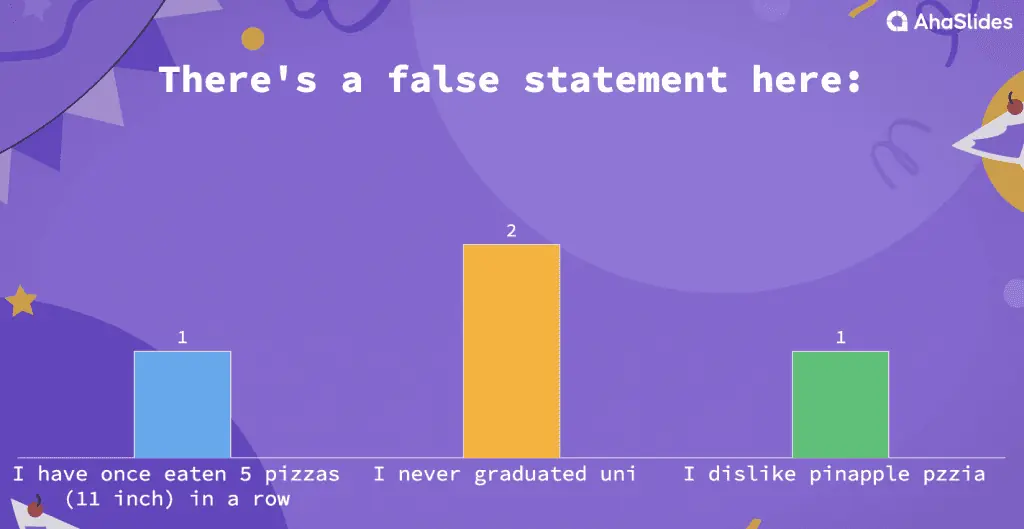
You might have heard of this one as a great icebreaker, but it’s also one of the top presentation games for checking who’s paying attention.
And it’s pretty simple to do. Just think of two statements using the information in your presentation, and make another one up. Players have to guess which is the one you’ve made up.
This one is a great re-capping game and works for students and colleagues.
- Create a list of 2 truths and one lie covering different topics in your presentation.
- Read out two truths and one lie and get participants to guess the lie.
- Participants vote for the lie either by hand or through a multiple-choice slide in your presentation.
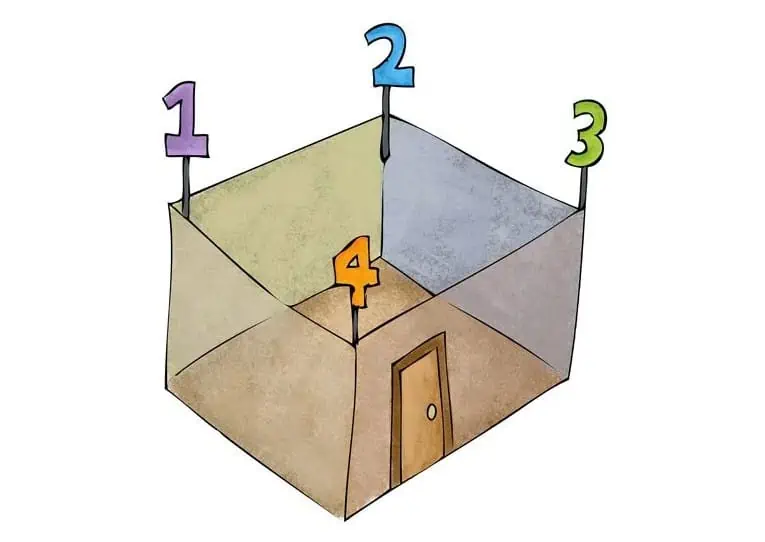
The best presentations are ones that spark a bit of creative thinking and discussion. There’s no better presentation game for evoking this than 4 Corners.
The concept is simple. Present a statement based on something from your presentation that’s open to different points of view. Depending on each player’s opinion, they move to a corner of the room labelled ‘strongly agree’, ‘agree’, ‘disagree’ or ‘strongly disagree’ .
Maybe something like this:
An individual is shaped more by nature than nurture.
Once everyone is in their corner, you could have a structured debate between the four sides to bring different opinions to the table.
- Set up the ‘strongly agree’, ‘agree’, ‘disagree’ and ‘strongly disagree’ corners of your room (if running a virtual presentation, then a simple show of hands could work).
- Write some statements which are open to different opinions.
- Read out the statement.
- Each player stands in the right corner of the room, depending on their view.
- Discuss the four different viewpoints.

Live word clouds are always a beautiful addition to any interactive presentation. If you want our advice, include them whenever you can – presentation games or not.
If you do plan to use one for a game in your presentation, a great one to try is Obscure Word Cloud .
It works on the same concept as the popular UK game show Pointless . Your players are given a statement and have to name the most obscure answer they can. The least-mentioned correct answer is the winner!
Take this example statement:
Name one of our top 10 countries for customer satisfaction.
The most popular answers may be India, USA and Brazil , but the points go to the least mentioned correct country.
- Create a word cloud slide with your statement at the top.
- Players submit the most obscure answer they can think of.
- The most obscure one appears most diminutive on the board. Whoever submitted that answer is the winner!
Word Clouds for Every Presentation
Get these word cloud templates when you sign up for free with AhaSlides!

For Ice Breaking

For Testing

This one’s a great game to use in the classroom, but if you’re not looking for presentation games for students, it also works wonders in a casual work setting.
Heart, Gun, Bomb is a game in which teams take turns to answer questions presented in a grid. If they get an answer right, they either get a heart, a gun or a bomb…
- A ❤️ grants the team an extra life.
- A 🔫 takes away one life from any other team.
- A 💣 takes away one heart from the team who got it.
All teams start with five hearts. The team with the most hearts at the end, or the only surviving team, is the winner!
- Before starting, create a grid table for yourself with either a heart, gun or bomb occupying each grid (on a 5×5 grid, this should be 12 hearts, nine guns and four bombs).
- Present another grid table to your players (5×5 for two teams, 6×6 for three groups, etc.)
- Write a figure stat (like 25%) from your presentation into each grid.
- Split players into the desired number of teams.
- Team 1 chooses a grid and says the meaning behind the number ( for example, the number of customers last quarter ).
- If they’re wrong, they lose a heart. If they’re right, they get either a seat, gun or bomb, depending on what the grid corresponds to on your grid table.
- Repeat this with all the teams until there’s a winner!
👉 Get more interactive presentation ideas (interactive PowerPoint ideas) with AhaSlides.
#9: Match Up – Interactive Presentation Games
Here’s another quiz-type question that can be a great addition to your roster of presentation games.
It involves a set of prompt statements and a set of answers. Each group is jumbled; the players must match the information with the correct answer as quickly as possible.
Again, this one works well when the answers are numbers and figures.
- Create a ‘Match Pairs’ question.
- Fill out the set of prompts and answers, which will automatically shuffle.
- Players match each prompt with its answer as fast as possible to score the most points.
If there’s a more versatile presentation game tool than the humble spinner wheel , we aren’t aware of it.
Adding the random factor of a spinner wheel might be just what you need to keep engagement in your presentation high. There are presentation games you can use with this, including…
- Choosing a random participant to answer a question.
- Choosing a bonus prize after getting an answer correct.
- Choosing the next person to ask a Q&A question or give a presentation.
- Create a spinner wheel slide and write the title at the top.
- Write the entries for the spinner wheel.
- Spin the wheel and see where it lands!
Tip 💡 You can choose the AhaSlides spinner wheel to use your participants’ names, so you don’t have to fill in the entries manually! Learn more interactive presentation techniques with AhaSlides.
This one’s a great way to turn a regular end-of-presentation feature into a fun, engaging game.
It’s got all the hallmarks of a standard Q&A, but this time, all the questions are written on balloons.
It’s a super simple one to set up and play, but you’ll see how motivated participants are to ask questions when it involves balloons!
- Hand out a deflated balloon and a Sharpie to each participant.
- Each participant blows up the balloon and writes their question on it.
- Each participant bats their balloon to where the speaker is standing.
- The speaker answers the question and then pops or throws away the balloon.
🎉 Tips: Best Q&A Apps to Engage With Your Audience | 5+ Platforms For Free in 2024
So, how do you feel about AhaSlides’s creative ideas for presentations? Being by far the most popular presentation tool on the planet, you may want to know if there are any presentation games to play on PowerPoint.
Unfortunately, the answer is no. PowerPoint takes presentations incredibly seriously and doesn’t have a lot of time for interactivity or fun of any kind.
But there’s good news…
It is possible to directly embed presentation games into PowerPoint presentations with free help from AhaSlides.
You can import your PowerPoint presentation to AhaSlides with the click of a button and vice versa , then place interactive presentation games like the ones above directly between your presentation slides.
💡 PowerPoint presentation games in less than 5 minutes ? Check the video below or our quick tutorial here to find out how!
What are the benefits of playing interactive presentation games?
Interactive presentation games boost engagement, participation and knowledge retention. They turn passive listeners into active learners by incorporating elements like live polls , idea board , quizzes, word clouds and Q&A .
How do you make a presentation interactive with games?
– Match your content: The game should reinforce the topics being covered, not just be random entertainment. – Audience considerations: Age, group size, and their knowledge level will inform game complexity. – Tech tools & time: Consider tools like AhaSlides, Mentimeter Alternatives , Kahoot , etc., or design simple no-tech games based on the time you have. – Utilise appropriate questions, including icebreaker games questions or general knowledge quiz questions
How can I make my presentation more engaging?
Making presentations more engaging can be a challenge, but there are several techniques you can use to make your presentation more interesting and memorable, including (1) start with a strong opening (2) use lots of visual ads and (3) tell attractive story. Also, remember to keep it short and sweet, and of course, practice a lots!

Lawrence Haywood
Former ESL teacher and quiz master converted to the wild slide. Now a content creator, traveller, musician and big time slider preaching the good word of interactivity.
Tips to Engage with Polls & Trivia

More from AhaSlides

12 Interactive PowerPoint Activities Your Students will Love

At Slides with Friends, we're all about trying to make your life as a teacher a little bit easier. We want to provide as many tools, tips, and as much support as possible. That's why we share on topics like Review Games , Student Wellness Activities , and Tools for Measuring Student Engagement .
While we usually focus on how you can use Slides with Friends specifically, we want to bring you something a little different this time. We've compiled 12 of our favorite interactive PowerPoint activities you can use with your students. All of the activities are designed to engage your students in ways they'll love. Even better, these activities let you use a tool you're probably already familiar with.
And read to the end for an exciting new announcement!
Annotated Images
Annotated images let you teach history (or literature! or geography!) using detailed annotated images from your latest lesson. We're big fans of using visuals in the classroom. And with good reason! A study released by the Journal of Education and Practice found visual information is mapped better in students' minds across multiple types of thinking skills. By introducing more visuals to a lesson plan, and using tools like PowerPoint, lessons are more likely to be remembered.

You can introduce annotated images on PowerPoint by picking out relevant images and adding captions or labels to them and presenting them as you teach. You can add descriptions, draw arrows, or points of interest on the image.
Check out this fun example from Ditch That Textbook .
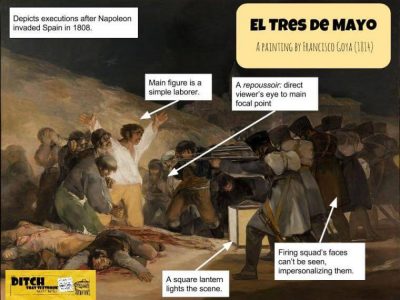
Even better, provide a few unique images of the lesson you just presented and have the students create their own annotations. Then, as a class, have each student present their image in PowerPoint.
Photos as Story Prompts
More visual learning! Using photos as storytelling prompts can be a great way to spark your student's creativity! PowerPoint is an ideal platform to display the photos, as it provides you the flexibility and versatility to show one photo at a time in case you want the students to focus exclusively on that image.
Simply ask them to write a story based on the photo in 1-3 sentences, and compare answers afterward. Encouraging different interpretations of a single image also helps foster critical thinking skills and encourages students to use their own perspectives when expressing their ideas.
Interactive Maps
Interactive maps are a fantastic way for students to learn about their world without leaving the classroom! And one of the easiest ways to show off these maps is through PowerPoint. Plus, PowerPoint makes adding hyperlinks to specific places (like pins), so you can click through areas of interest without having to open up a separate browser page.
If you're looking for a simple tutorial on how to create a lesson-based interactive map, check out this one from eLearning Industry . For more exploratory maps, check out the tutorial below (which includes the free template!).
Battleship Review Game
We love a good game here at Slides with Friends, so it shouldn't be a surprise to see so many options on this list. However, before doing research for this article, we had no idea Battleship could be played on PowerPoint!
In the template below, you can add words and to reveal the space beneath the words, students have to:
- Conjugate the Verb
- Use the Word in a Sentence
- Define the Word
Or one of any fun combinations.
We love this idea for language classes especially, but can also be used for vocabulary in any subject.
You can check out the whole presentation here.
Crossword Puzzle
Crossword puzzles are a timeless and popular way of testing knowledge and keeping minds alert. They can be used in the classroom to reinforce concepts and skills related to any subject, making them a great teaching tool. Crosswords can help students learn new vocabulary words, polish their grammar, understand history or science topics better, or firm up mathematics concepts.
And an easy way to do a crossword in the classroom is by using PowerPoint. You simply need to create a blank and a filled puzzle on PowerPoint and then fill it out with your class.
Check out this step-by-step guide on the best way to quickly create a crossword puzzle in PowerPoint.
Tests and quizzes are absolutely no fun, so if you can find an easy way to quiz your students in a fun way, that's a win-win! One of our favorite ways to do this is by creating a quiz show on PowerPoint.
By using those hyperlinks we mentioned above, you can easily create your own questions, assign point values, and include sound effects (or music!) to make your students feel like they're actually in a game show!
This 6 Steps to Create a Multiple Choice Quiz is a great way to start designing your next PowerPoint quiz. If you're looking for multiple ways to create a quiz show for your students, check out the detailed tutorial below .
Video Gallery
We've talked quite a bit about visuals here, not just because PowerPoint is a great tool for visuals, but because visuals are so extremely helpful in the classroom.
One way to incorporate visual activities into your classes with PowerPoint is by creating video galleries. This is especially useful if you have limited access to videos and need to play them in a certain order.
You can create a video gallery presentation by manually inserting the clips into slides or creating a series of hyperlinks to take the class through certain processes. You can also add captions, notes, and questions for further discussion.
Scavenger Hunt
A fun activity to incorporate in your classroom through the power of PowerPoint is a review scavenger hunt.
Scavenger hunts can be an engaging way to go over the material and test knowledge at the beginning or end of a unit. PowerPoint is a great tool to use when designing a scavenger hunt if you are working with students online. With the tool, you can hide clues in images, ask questions that are linked to hyperlinks, and even add video clips as hints.
Scavenger hunts also offer quite a bit of versatility in the classroom. You can have students work individually or in groups, depending on your goals for the lesson.
You can reference our Virtual Scavenger Hunt guide, which includes several hunt lists, for ideas on what to bring to your students.
Choose Your Own Adventure
PowerPoint slides can also be used to create engaging interactive experiences. PowerPoint's slide-linking feature allows you to jump between slides with the click of a button, providing users with their own “Choose Your Own Adventure”-style gaming experience. As a result, you can create an interactive story with a different ending each and every time.
While this activity will take quite a bit of upfront work, once you have it done, you can use it for countless classes.
We highly recommend this tutorial by The Training Lady on how to plan out your next PowerPoint adventure!
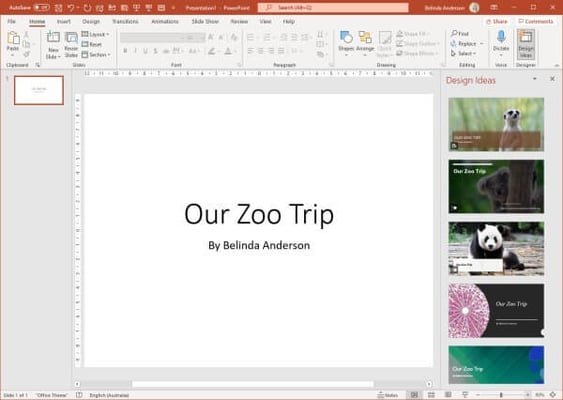
Picture Reveal
Picture Reveal is a great PowerPoint activity that encourages students to think critically. In this activity, you can present an obscured picture and provides clues as to what it could be. Students must then utilize their knowledge and logic skills to work out what the picture is by eliminating incorrect answers based on the clues provided until they eventually get the correct answer.
Picture reveals are a great way to review material from previous lessons or current topics. They can also act as an introduction to a new lesson. Plus, we can't stress this enough, visuals!
Word Search
Word search games are a great way to review vocabulary and help students learn new words. Using PowerPoint, you can create custom word searches by entering the target vocabulary words in a grid. Then draw lines connecting each letter to form words! You can even add visuals that correspond with the theme of your word search for an extra challenge.
Word search games are perfect for when you have some leftover time during class or if you want to review material from earlier units. A PowerPoint word search is also great for helping students recognize spelling patterns in unfamiliar words and promoting active learning as they look for the hidden words in the puzzle.
Student Presentation

One of the best ways to get your students engaged in the classroom is to have them lead the show. And PowerPoint is such an awesome tool for students to present their own material.
With a little guidance, you can have older students create mini-presentations about topics they've studied in class or even on their own. Not only will this allow you to assess what they've retained from studying, but it also allows your students to practice public speaking skills and become more comfortable with online presentations - essential in today's digital world!
With PowerPoint, you can easily turn any student project into an engaging presentation everyone will enjoy.
Use Slides with Friends for Your PowerPoint Activities
PowerPoint has been a vital tool in the teacher toolbox for decades. There are so many fantastic ways to use PowerPoint to engage and interact with your classroom.
Slides with Friends is excited to announce a new feature for our slide decks - A PowerPoint upload!
Now you can create your slides in an already-known program, or use slide shows you've already made, and with a click of a button upload them to Slides with Friends!

Slides with Friends brings classroom PowerPoint activities to the next level by enabling real-time collaborative engagement from all of your students. By combining your PowerPoint presentations with Slides with Friends live word clouds, polling, trivia, and quizzes, as well as photo sharing, you really can fully involve your students in every lesson.
Subscribe for more articles like this
Try slides with friends for free.
The easiest way to host meetings your team will love
Engagement delivered to your inbox
We'll email you 1-2x per month with brand new, ready-to-run events and ideas. Subscribe to stay ahead of the curve and keep your lessons, meetings, and events fresh and engaging.

20 Interactive Presentation Games
- Employee Engagement , Event Planning , Leadership Techniques

Meetings and conferences can be painfully tedious and dull. So much so that the phrase “Death by PowerPoint” has made it into our lexicon. According to Thomas Sowell , an American political economist and commentator, “People who enjoy meetings should not be in charge of anything.”
But if the problem with meetings is that they tend to be boring, the solution lies in finding ways to better engage and entertain your audience. You probably know the feeling of sitting in a meeting, trying to pay attention while one person drones on for an hour.
Even if the purpose of the meeting is to train, disseminate new developments, or even get everyone up to speed on weekly goals, engaging your audience creates a motivation to pay attention.
That’s why interactive presentation games are a great way to re-energizing meetings by involving audiences in the presentation. Interactive presentation turn passive listeners into active participants. Games allow the attendees to learn new skills, think of solutions within a short time period, and solve problems together.
MeetingPulse equips your team with the tools and resources to create engaging events. With that in mind, here’s our guide to a few popular interactive presentation games.
Related: Creating a Positive Organizational Culture while working remote
1. Project Jeopardy

This game is designed to make the presentation of reports more fun and interactive. The lead person on the report creates cards that have answers from the report.
For example, the card reads “25%.” The rest of the team is supposed to ask the correct question corresponding to the “25%” answer on the card. The question could be something like, “What was the company revenue growth for the quarter?”
How to play: Give everyone the URL to your MeetingPulse meeting. Display the question on your screen and create multiple choice answers or leave it open-ended. The answers will pop up on the administrator’s screen in real-time, and you can share the answers to see how many people got it right.
2. Idea Box Game

The Idea Box game is excellent for brainstorming meetings where employees can share ideas about a project or product . It helps get the creative juices flowing and might even lead to some usable prototypes. Instead of having one speaker after another speak about their idea, having a team create an idea box creates a space for collaboration to further spark innovation.
How to play: Use the MeetingPulse brainstorming tool to have teams vote and collect feedback about the products. Have each attendee log in to your MeetingPulse link — a virtual Idea Box. Give small groups thirty minutes to brainstorm, then allow submissions.
At the end of the exercise, each team should have the product name, features and functions, marketing taglines, and other vital product details.
Once each team has completed their box they’re invited to share it with the rest of the team who finally vote for the best box. Their ideas will appear on the screen right away, and participants can upvote or downvote in Reddit-style fashion and even submit emoji reactions.
3. The Introduction Game

This game is ideal for a new group of team members meeting for the first time on a mutual project or new hires joining a team. Give the new hires a chance to introduce themselves in an unforgettable manner.
How to play: Ask the new members to bring a personal item or a favorite song. During the meeting, introduce them by letting their song blare for a few minutes on the sound system and then ask them to say something about themselves. If you’re using the personal item, ask them to talk about the item and what it means to them.
4. The talking stick

This activity makes sure that anyone who has a contribution not only gets to do so, but also that they get to speak uninterrupted. Using the talking stick is a great, rapid-fire way to focus the meeting on deep and meaningful contributions.
How to play: Form a circle and make sure everyone’s seated. Before the discussion begins, everyone should agree that the moderator has the power to choose whoever speaks next. Once a member finishes talking, they should put the stick back in the center for the next person.
Use the MeetingPulse audience feedback capability to gain insight right away. Choose up to four emojis and allow your audience to react as they listen to new ideas.
5. Telephone game

The telephone game is used typically as an ice breaker or to liven up a group after a couple of mind-numbing presentations. While it doesn’t really work with a very large group, a sizable number like 10 to 15 people is just right.
How to play: The meeting leader whispers the latest company marketing strategy used to the person on their left who is then supposed to relay the message to the next person and on and on until the last person gets the message.
The last person then gets to tell the rest of the team the final message, and you can compare it to the primary message from the lead.
6. The trivia competition

You can use this game to test the attendees’ trivia knowledge of the company or of general business trends . Create a trivia competition where the members play for points and the winner gets a prize. Project the points for everyone to see the winner.
How to play: Formulate questions related to the company and use them for the trivia test. You can use MeetingPulse to create the questions, and set the timer to begin the game together. To add an extra touch of fun, include images with your multiple choice questions. Visuals add to the level of engagement and give your meetings an extra edge.

7. Fill in the phrase

Check out Meeting Pulse for Cool and creative ways to make polling questions and Quizzes!
This game requires participants to fill in blanks on a survey or report. The survey or report should not be complete until the end of the presentation. This game rewards audiences for listening, and you can even provide some sort of prize.
How to play: Create a report for attendees that has blanks. As you continue with the presentation, invite them to fill in the blanks from the information you are giving. Not only does the audience remain engaged, but they retain crucial information better.
MeetingPulse integrates with Powerpoints , so you can use our single answer polling feature to play this game and display the results directly in your PowerPoint presentation.
8. Word of the day

Have a word of the day game as part of your presentation or meeting. It can be a phrase or a word.
How to play: The presenter should weave the word or phrase into their presentation and the audience acknowledges its use by shouting back. The word must come from the team and not the presenter. This activity keeps everyone alert. Sometimes shouting can be distracting in the middle of a meeting.
In this case, use the MeetingPulse emoji feature, and everyone can submit ? when you use the word “key learnings.”
9. The 20 questions game

You get 20 questions to help you identify a picture that you can’t see, but the audience can. The audience can only lead you with yes or no questions. Use this game to liven up the audience.
How to play: The audience will choose a picture that you can’t see. Have someone submit a photo and display it on the MeetingPulse user dashboard. Get blindfolded and begin to ask questions regarding the picture. You get only twenty questions to get it right.
If you’re an advertising agency, you can use this test your employees’ memory and see if they remember what you worked on. To keep track of all the questions and responses, have the audience choose “yes” or “no” by using a polling tool instead of having them shout it out.
10. Call and response

This game keeps the audience focused. The leader in the meeting calls out a phrase randomly during their presentation and the audience responds to it .
How to play: Agree on the action to be taken every time the phrase is called out. The second the presenter calls out the word, your audience can dance, clap or just rise and seat. Alternatively, they can respond with a phrase, word, or an emoji using MeetingPulse.
11. What would I have done?
In this game, ask each member of the team what their alternative career would be. The point of the game is to open up to each other and foster conversation.
How to play: Each member writes down their alternative career and waits their turn to reveal. The audience collectively asks “What would you have done?” and the selected member responds explaining why they chose that alternative. This is another great game you can play virtually, especially if you’re working with a big team.
With MeetingPulse , you can find out everyone’s alternative career and even get some statistics.
12. Fabulous flags

In this game , team members draw things that matter to them on their flag. This is known as the personal flag game, and it’s an excellent ice breaker activity.
How to play: Everyone gets 10 minutes to draw objects or symbols that represent something meaningful in their lives. Each person gets two minutes to explain the items on their flag.

13. Botticelli

Similar to 20 questions, this game also tests your trivia. You keep in mind a person, place, or thing, and the audience has to guess. The game is a bit more complex because the player can talk back to the audience and distract them from the name.
How to play: The audience asks leading questions to which the player responds with a yes or no. If they ask a specific question like “Does the celebrity’s name start with B?” then the player can respond with “It’s not Brad Pitt.”
This game is logistically easy to plan because all you need to do is formulate the poll questions and integrate them into your PowerPoint with MeetingPulse .
14. Candy introductions

This is a game that allows people to get to know each other while enjoying some sweet treats. It’s excellent for training sessions where participants are complete strangers, providing general topics for introductions that employees can elaborate upon further.
How to play: The participants choose different types of candy from a bag and use each to represent different topics about themselves during the introduction. They can talk about family, career, hobbies, unexpected characteristic and dream destinations.
15. Crazy job interview

In this game, one participant tries to convince the others why they would be the best for a certain job. They have to expound on qualities given by another player and how those qualities make them a good fit.
How to play: The participant is given a career, like a supermodel. Then they are given random phrases like “angry with the queen” or “intellectually incompatible” and they have to use these phrases to explain why they would be great at being a supermodel.
16. The elimination game

The elimination game helps participants to get to know each other, using a series of questions to find out the most common and most rare similarities amongst people within your company.
How to play: The whole room is asked to stand up. The leader then asks elimination questions like “how many are attending this conference for the first time?” That group gets to sit down. The next is “remain standing if this is your fourth consecutive attendance.” The rest of the group sits down. And the elimination questions continue.
17. Would you rather

This is a fun game to liven up the room, giving participants two choices of something they can do. They have to choose the lesser evil.
How to play: The player is given a question with two very bad or very good outcomes. For example, if the employees are afraid of heights, ask, “Would you rather go sky diving or bungee jumping?”
If you want to play this game with a large group of people, you can use MeetingPulse to get answers in real time. This game can also provide valuable insight for you. For instance, you can ask, “Would you rather have a breakfast spread or small desserts for our next meeting?”
18. Anagrams
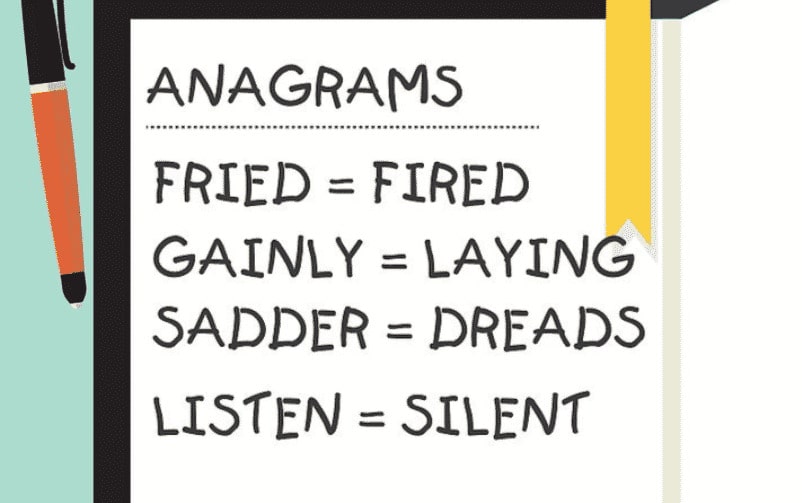
Think up a word and have everyone else try to figure it out. Expect some hilarious answers as everyone chips in.
How to play: Jumble up the letters but ensure that they create a five or six letter word anagram when correctly aligned. Only the presenter should suggest the word, and the activity should be timed. People can submit their answers live on MeetingPulse .
19. Two truths and a lie

The players get to tell two truths and one lie about themselves and the audience deciphers which one is the lie.
How to play: The player chooses a topic, like “career.” They tell two real facts about their career and one lie. The audience then decides which statement is false and why they believe that.
20. Choose the Agenda

In this activity, the participants choose the agenda of the meeting instead of being told what it is. This allow them to address burning issues.
How to play: Participants are invited to submit their agendas, which are shared by everyone and then voted on. The one with the most votes becomes the main agenda for the meeting. This gives participants control over the meeting as well.
You can use MeetingPulse’s brainstorming tool with the upvoting feature for this!
Final Thoughts
Now that you know some of the best interactive presentation games, you’re ready to host your next event with new and creative ways to keep your audience engaged. MeetingPulse is a great tool and resource for you to make your presentations more memorable and — dare we say it — fun.
Related: 25 Fun Poll Questions to Ask Your Audience
Get started with MeetingPulse today!
Share this article on your socials, latest posts.

The Benefits of Language-Inclusive Meetings and Events

Understanding the Pain Points of Language Barriers at Your Meeting and 7 Tips for Breaking Them Down with Technology

There’s only one way to determine if customers are satisfied – ask them

Proactively Managing Employee Engagement, Development, and Satisfaction
Blog categories.
- Audience Response Tools
- Best Practices
- Employee Engagement
- Event Planning
- Hybrid Events
- Leadership Techniques
- Meeting Prep
- Organizational Development
- Uncategorized

To make MeetingPulse a seamless addition to your meetings, we offer custom themes. You can use your own logo and your colors in Attendee View as well as Broadcast View. Your company name can also be included in the webpage’s title. Your meeting can also have its own domain. This is great if you are going to promote your meeting offline. For example, you could use “acme2022.com” instead of “meet.ps/acme-all-hands”.

Live Product Tours
Weekly Product Tour Every Wednesday

- Success Stories
- Integrations
- Help center
- Cvent Marketplace
- Connect with Zapier
- Trust Center
- System Status

- What solution is best for me?
- Download the Government eBook
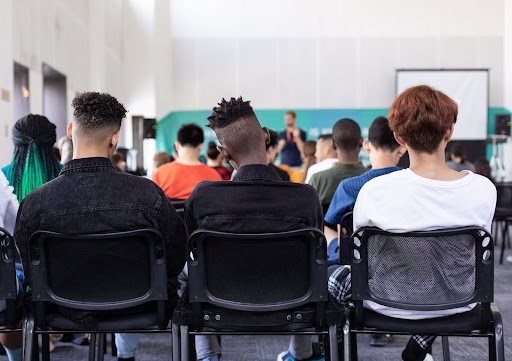
13 Interactive Presentation Ideas to Engage Students in Class
If you’re a teacher, you’ll know that there’s a lot to think about when you’re in class. It’s important to ensure that what you’re teaching the children is as educational and as interesting as possible - with the aim of engaging the students in the subject and hopefully even enabling them to enjoy learning!
This can be a very difficult balance to strike. However, it’s made easier by these interactive presentation ideas listed in this article, which can engage even the most distracted of students!
How to display presentations
The best classroom gadget to show these presentations on is an interactive display. These are large devices that are mounted to the wall and can connect seamlessly with any video collaboration applications. You can connect interactive displays to the internet and further use them as a powerful classroom teaching tool, to help students learn in a fully interactive and efficient way. We sell interactive displays for classrooms here at Avocor.
Interactive class presentation ideas
Ice breakers.
Many work-related presentations start with an icebreaker, and there’s no reason why a presentation to a class of students should be any different.
The icebreaker question will depend on the class and age of students, but could be something like the following:
- If you could be an animal, what would it be and why?
- What would be your dream place to go on holiday?
- If you could have dinner with three historical characters, who would they be and why?
- If you could make any kind of potion, what would it do?
Incorporating video is one of the best interactive presentation ideas for students. Even if the video is about the same topic as the presentation, the fact that it’s a different type of media will interest the class.
You can either find a suitable video on YouTube or another video software or, if you have a file saved, paste it directly into the presentation .

Questions and answers
Questions and answers are a great way to get the whole class involved. You could invite one student to ask a hypothetical question about the topic, and another could answer.
For example, if you’re learning about Henry VIII and his six wives , you could ask a student to ask a question about them. Their question could be “what was Henry VIII’s favourite food?” or something similar.
When another student answers, you could ask them to explain their answer - for example, if they say “meat and bread”, they might carry on to explain that that was the main diet for royalty at the time.
Songs are a good way to interest younger kids in a topic. You can find songs about all sorts of subjects on YouTube. For example, this seven continents song could be suitable for a Geography song.
Many songs on YouTube have lyrics, so you could encourage your class to practice their reading as they sing along.
Some presentations are made more interactive by external objects - and if you want to engage younger kids, bringing some props can really help the lesson to come alive.
For example, if you’re doing a history lesson about the Ancient Egyptians , you could bring some figures of Tutankhamun, the Sphinx and the ancient pyramids for everybody to see.
Class involvement
Asking for direct class involvement throughout the presentation is a good way to ensure that students stay engaged. For instance, if you’re doing a presentation about animals, you could ask students to make a noise every time you mention a certain animal.
You could ask them to roar each time you mention lions, or make a monkey noise each time you talk about monkeys. This is a great way to ensure that the students are paying attention!
Transitions and animations
A simple way to ensure that your students are paying attention is to use different transitions and animations throughout your presentation.
If you’re teaching older kids or teenagers, you might not want to have too many of these, but younger kids will love seeing every item bounce onto the screen. It’s a wonderful way to get them interested in technology in the classroom !
Quizzes are an effective way to engage students of any age. You can include these at the end of the presentation and they can include questions that you’ve covered in the session.
If your students know that there will be a quiz at the end of the class, they may be more likely to pay attention throughout it! You could also ensure maximum engagement by telling students that there will be prizes for the winner of the quiz - such as stickers or sweets.
Interactive games
Interactive games for class presentations are always a popular way to ensure that students stay engaged! Some examples include:
- noughts and crosses or tic tac toe
- pictionary
- hangman or an alternative like spaceman
- 21 questions
It’s best to make these games related to the subject. For example, the game “21 questions” involves you thinking of a character and students asking questions with a yes or no answer about what character you are.
If you’re teaching a history class, the character could be somebody from history (such as Florence Nightingale or Queen Victoria), or if you’re instructing a science lesson, the character could be a famous scientist (like Einstein or Steven Hawking).
Brainstorming
Brainstorming is another great way to get the class involved. You can use an interactive display to create the brainstorm diagram on. Students can take turns writing on the board, and it can securely connect to any external devices, so any remote class members can join in.
With an interactive display, you can also immediately share the diagram to the rest of the class once it’s finished, so they can keep it to refresh their knowledge of a topic.
For example, if you’re teaching your class about Australia in geography , you could ask their students what they may already know about Australia. They could come up with some items like the following:
- Sydney Opera House
- Aboriginal art
- outback
You could then create a spider diagram with different legs depending on the topic. For this list, there could be an “animals” leg for kangaroos and koalas, an “architecture” leg for the Sydney Opera House, a “landscapes” leg for the rainforest and outback, a “culture” leg for Aboriginal art and a “food” leg for BBQ.
Make a story
Making a story about the topics covered can encourage creativity around the topic. To do this, write down a couple of opening lines to a story related to the topic that you’re teaching.
For example, if you’re teaching students about the Ancient Roman Empire, you could start by saying “Ronald the Roman lived in the British City of Bath, where the Romans had arrived 20 years before. He spent most of his time at work, where he built houses for the rest of the Romans”.
Then, you could invite a student to continue the story, encouraging them to stay as on-topic as possible. You could even give out a prize to the student with the best part of the story. Depending on the size of the class, you could ask every student to contribute.
Stories also work well for English lessons. In these classes, the topic of the story doesn’t matter as much, but you could encourage students to use whatever language they’ve been learning.
For example, if your class has been focused on adjectives, you could ask students to put as many adjectives as possible in each part of their story.
Have a short play
You could take your stories to the next level by creating a short play on one of your slides. This could be based on whatever topic you’re learning about, and you could select a few students to come to the front of the class and read out the lines.
You may wish to create this personally, find a relevant play online or you could even turn a well-known story into a play!
Virtual field trip
One of the most creative interactive school presentation ideas is to take the class on a virtual field trip. This is particularly valuable for geography lessons, where you may learn about places that students might not be able to visit in person, like the Amazon rainforest or even under the sea!
You could link to Google maps, where you could use Google Earth to explore a particular area. Alternatively, there are some YouTube channels that specialise in virtual tours and field trips, such as this one which details all you need to know about rainforests .
If you have a classroom full of students and want to keep them as engaged as possible while teaching them new material, try some of these interactive games for classroom presentations and other ideas!
By incorporating some of these interactive ideas into your presentation, you’ll have the students’ full undivided attention and ensure that they not only enjoy the class but retain the information.
Related Articles
Interactive office spaces: 8 tips to improve workplace interaction, meeting equity: how does being inclusive benefit a workplace, elevate your space with avocor x series: the award-winning sleek solution for impactful displays, elevate organizational efficiency with avocor: integrating montage and risevision, enhancing hybrid workspaces: microsoft teams meets avocor l series display, get in touch, sign up for our newsletter.
Keep up to date with all the latest from Avocor and partners and get information on upcoming events and exciting product news.

Latest Updates
Useful links, ready to talk.
To provide the best experiences, we and our partners use technologies like cookies to store and/or access device information. Consenting to these technologies will allow us and our partners to process personal data such as browsing behavior or unique IDs on this site and show (non-) personalized ads. Not consenting or withdrawing consent, may adversely affect certain features and functions.
Click below to consent to the above or make granular choices. Your choices will be applied to this site only. You can change your settings at any time, including withdrawing your consent, by using the toggles on the Cookie Policy, or by clicking on the manage consent button at the bottom of the screen.
- Interactive Display
- Accessories
- myViewBoard
- Multi-touch Series
- Professional - VP Series
- Business - VG Series
- Home and Office - VA Series
- USB-C Series
- Home Entertainment
- Sports Viewing
- Installation
- Presentation Displays
- Direct View LED Display
- Pen Display
- ViewSonic Education Solutions
- Touch Screen Solutions
- ViewSonic Library & Blog
- myViewBoard Resources
- Case Studies
- Solution Briefs
- White Papers
- Press Center
- Knowledge Base
- Product Warranty
- Español ( Spanish )
- Deutsch ( German )
- Türkçe ( Turkish )
Education | Sep 21 2019
5 Interactive Presentations Ideas that will Engage Students
Interactive presentations should always be an educator’s goal. Dry, teacher-centered lectures lose students’ interest, while interactive presentations grab and hold attention. Getting students involved improves retention, understanding, and enjoyment. And it’s remarkably easy to involve the audience with just a few easy principles (especially with the right technology at your disposal).
Start creating interactive presentations with the tips and tricks below or get more insights on modern education technology.
Students today expect the classroom to be both educational and enjoyable at the same time. Interactive presentations help engage students by having them participate in the lessons instead of passively listening to lectures. This reduces boredom and gives students a sense of responsibility to be attentive.
A Gallup Poll of about 3,000 schools shows that around the 5 th grade 74% of students feel they are engaged in school, but by the 10 th , 11 th , and 12 th grade those numbers fall to the 30% range. It is important for educators from K-12 and on to higher education to recognize that keeping students engaged in the classroom is important and the adoption of interactive learning environments can be a key driver.
Millennials and Generation Y students are especially accustomed to being a part of the lessons and not just a spectator. Students are encouraged to talk and offer their ideas to create a collaborative atmosphere where both teachers and students are sources of knowledge and insight. The teacher plays more of a facilitator role in moving the lesson along and encouraging students to participate in their own learning outcomes. Students offer their own input, additional information, and give examples of how they would apply the key concepts.
The learning task is the central aspect of the interactive presentations (instead of the teacher’s energy level and hold on the students’ attention spans) and the lessons evolve around it. Even though the teacher is normally, the ‘presenter’ in most cases the ‘interaction’ part comes in a variety of ways to get students participating in the lesson. Many activities, games, role-plays, quizzes, and discussions can be integrated into the presentation flow and the lessons will take different directions from there. We will discuss later many examples of tools and techniques to encourage collaborations.
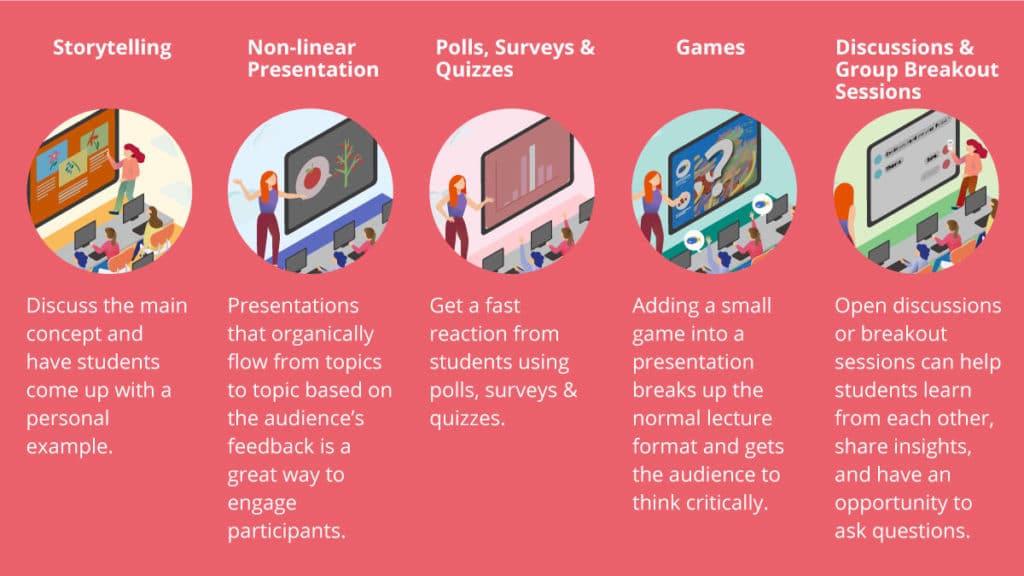
Technological Aid in Interactive Presentations
Although interactive presentations can be done without technology, it is greatly aided with the adoption of tools designed to facilitate the learning process. For example, a quiz is given in the middle of the presentation. On one side, traditionally a teacher can write the quiz before the lesson starts, print out copies for all students, pass out the quiz, and collect answers. To provide feedback for the exercise the teacher will also need to grade and start a discussion on the results before moving on to the next topic. This process is time-consuming and restrictive.
With technological aid such as an interactive digital whiteboard or a classroom quizzing application on individual devices, the students and teacher can come up with the quiz questions on the spot. This digital quiz can be administrated wirelessly to all students and within seconds, the results can be shared with all participants to discuss. This greatly increases spontaneity, variability, and class involvement.
5 Interactive Presentations Ideas and Corresponding Technology Aids
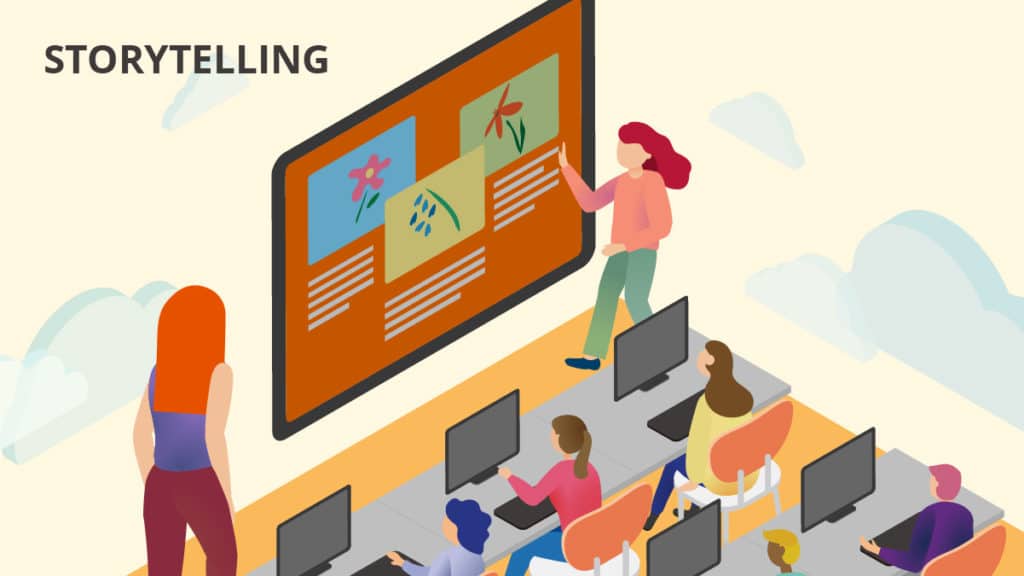
1. Storytelling
The teacher does not have to be the only star. The glory of the presentation can go to all participants who have a story to tell. The main concepts can be discussed and students should be given time to come up with a personal example. This exercise helps students relate to the subject matter and getting to listen to other students’ examples will drive home the concepts further. The need for the teacher to plan extensive examples and be the only one talking during the presentation is reduced. Teachers can also judge by the stories shared how much the students are understanding.
Storytelling with technology: Many digital whiteboards have Cast and Throw functions that will allow students to work on their own examples on their devices and send this to the whiteboard when sharing. This allows students to quickly go up and share their stories without sending files by email, wires, or USBs.

2. Non-linear presentation
Presentations that do not follow a strict order but organically flow from topic to topic based on the audience’s feedback are a great way to engage participants. Once prepared, the presenter can flow from one topic to the next by asking questions, polling, or receiving requests at the end of each key point. This allows the audience to ‘build’ their own presentation on what they want to hear not in a rigid manner as with traditional slide-based presentations.
Non-linear presentation with technology : There are non-linear presentation applications like Prezi which helps presenters build presentations on easy-to-customize templates. They offer a zoomable canvas (not slides) to help people share knowledge, stories and inspire audiences to act. The canvas shows relationships between points and offers a recommended flow but not a set path to follow.

3. Polls, surveys, and quizzes
One of the most recognizable and used tools in the classroom to get a fast reaction from students are polls, surveys & quizzes. For polls, simple questions that have limited answers are used to gather a consensus. This could be in the form of a raise of hands, ballots, or having students form groups. Surveys would require printed paper sheets with multiple choices, scales, or short answers to gather opinions. Quizzes are used to quickly test a student’s knowledge on what was just covered, so the class can identify weak areas and crystalize main concepts.
Polls, surveys, and quizzes can be anonymous or not. Openly requiring students to share their ideas on results such as a debate or open discussion would increase the interactives of the activity. Students can also be tasked to create questions and grade their own surveys and quizzes for an added layer of participation within the presentation.
Polls, surveys, and quizzes with technology : Many classroom management software such as Google Classroom has built-in tools to create polls, surveys, and quizzes along with assignments, communication, and other educational features. Once submitted, the collection and grading are instantaneous. The results can be shared easily with students both individually or as a group.
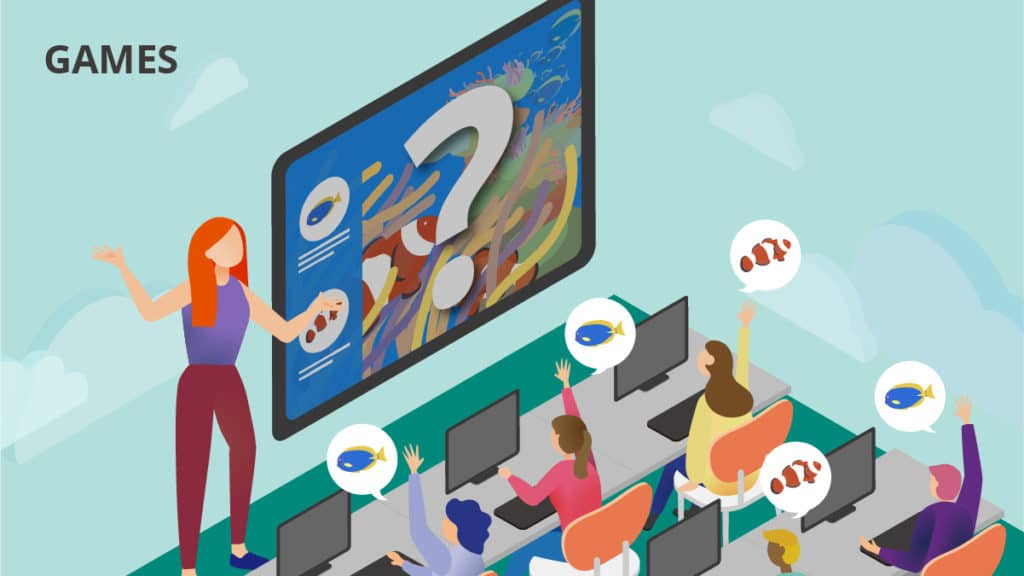
Is there a student – of any age – who does not like a good game, contest, or competition? Adding a small game into a presentation breaks up the normal lecture format and gets the audience to think critically to help their team win. There are many versions and adaptions of basic educational games . Teachers can take games such as Pictionary, Jeopardy, Casino, and Bingo then adapt them to their needs.
ViewSonic Originals
Free interactive teaching materials
Gamifying your interactive presentation : By integrating into the presentation links to applications like ClassCraft or Kahoot a teacher can quickly launch an interactive digital game. These applications help teachers tailor their own games by adding their questions, facts, and materials for individuals, small teams, or the whole class to participate.

5. Discussions and groups breakout sessions
Having the class only listen to a lecture marks the end of any interactive presentation. Adding sections where students can have an open discussion or breakout sessions can help students learn from each other, share insights, and have an opportunity to ask questions to their peers. It is also an opportunity for the teacher to take a break from talking and help small groups or students individually as the rest of the class converse.
Taking the discussion online for interactive presentations : Live discussion applications like NowComment allow students to markup and discuss a text in real-time which is great for peer-review activities and gather student input into one place quickly. Alternatively, Yo Tech is great for teachers to create and moderate real-time chat rooms. Students can send text-like messages, reply to other messages, and share pictures and drawings. Online chat groups are a great way for large groups of students to collaborate and interact in one place while keeping the noise level down in a classroom.
Tips for Creating Interactive Presentations
Here are some tips when creating a presentation that has interactive components:
Add in places within your lecture notes or presentation slides reminders for you to engage the audience. This could be a small image or phrase. When using digital whiteboards or other display technology you could also use a sound, empty slide, or pop-up link to prompt you to start.
Time Limits
It is great to keep going a good game or discussion in the class where everyone is really engaged. However, keep the maximum amount of time you can dedicate to these activities in mind. Have a watch or a timer on hand and keep things moving. Give enough time for students to get engaged without overdoing it. Spread out chances for students to talk and share. When it is time to move on to the next topic prepare a transition to the next part of the presentation.
Think of ways to let all students have a chance to share. You can select students randomly or have them take turns in some kind of order. Remind students that this is a learning activity and not everyone will get it right the first time. The interactive activity should be open and inclusive. Students who are introverted may be given activities that can be done without going to the front of the class or public speaking.
Benefits of Having Interactive Components in Your Presentation
- Retention: Actively having students engage with the concepts of the presentation in different ways and hearing it from different people (besides the teacher) helps with long-term retention.
- Personalization: Students are given the choice of where the presentation is heading and participate in their own learning outcomes.
- Fun: Having a break from the routine, getting a chance to move around, developing teams, and sharing are all much better than sitting silently and taking notes.
- Feedback: Adding interactive activities into a presentation gives you instant feedback about students’ comprehension.
- Vocalization: Having students actually vocalize their ideas helps them internalize the concepts.
- Summarization: Students review and summarize their own main points while doing the activities so there is less need for repetition.
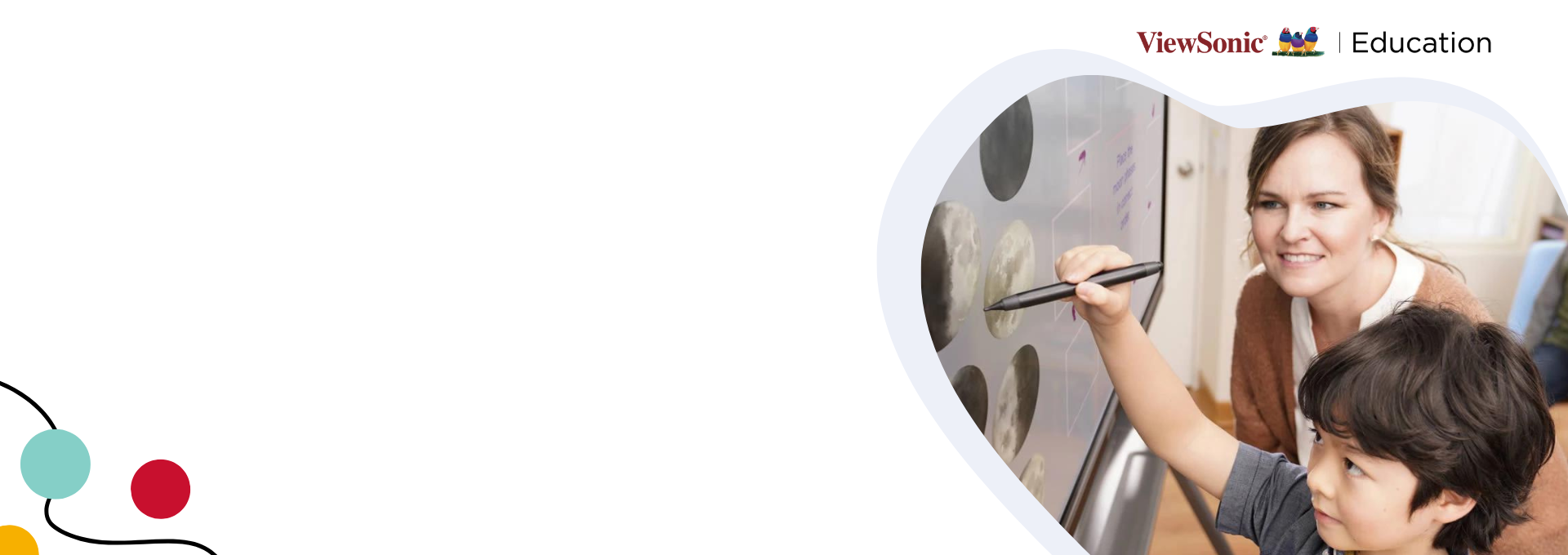
ViewSonic Education
Learning Solutions For the Future
Build Your Own Version of Interactive Presentations for Your Next Lesson
Bringing in the interactive components and increasing the engagement of your presentations will both help you – a teacher – and your students. Make presentations both educational and entertaining with Edutainment! With or without technology, consider incorporating some new ideas into your next interactive presentation.
If you liked reading this article, you might also want to explore our complete guide to technology in the classroom or gain more insights on engaging lessons with ViewSonic’s education solutions.
RELATED ARTICLES
Technology in the Classroom | May 23 2024
Creating Modern Classrooms: 3 Contemporary Approaches to Classroom Design
Discover how modern classroom design transforms education with adaptable, inclusive, and sustainable spaces where every student can thrive.
Education | Mar 14 2024
Introducing Multimedia Learning Design in Education – By Owen Matson, Ph.D.
Owen Matson, Ph.D. introduces multimedia learning in education and offers educators strategies to incorporate it into their teaching methods.
Professional Development | Jan 26 2024
Why Every Teacher Needs Their Community
Discover how teacher communities provide opportunities to learn, collaborate, and grow on an educational journey with like-minded peers.
Professional Development | Jan 18 2024
The Power of the ViewSonic Education Ecosystem
The ViewSonic Education Ecosystem blends hardware, software, and services to empower educators, enhance learning, and streamline operations.
SELECT YOUR REGION
Asia pacific & africa.
5 Interactive PowerPoint Game Templates for Unforgettable Lessons

Ausbert Generoso

In the digital age, PowerPoint has evolved far beyond its traditional role as a static slideshow tool. It has emerged as a versatile canvas where creativity knows no bounds, and where education and entertainment can seamlessly co-exist. Imagine captivating your audience not just with information but with an interactive journey that sparks curiosity, competition, and camaraderie. This is the magic of PowerPoint games.
📸 Picture this: a classroom abuzz with excitement as students eagerly participate in a trivia quiz that feels more like a game show. Or a virtual conference where attendees don’t just listen passively, but actively engage with the content, making choices that shape the narrative. The secret behind these captivating experiences lies not just in PowerPoint itself, but in the innovative tools that unlock its true potential.

In this blog, we will explore the art and science of creating games that educate, entertain, and leave a lasting impact. We will delve into the principles of gamification with actual, downloadable PowerPoint game templates powered a subtle yet potent ally that can further elevate your game. Follow along so you would know what this power tool is!
Table of Contents
8 Editable PowerPoint Game Templates
Engage your audience with these interactive PowerPoint Games. Customize these templates to fit your very own topic and presentation. The file includes templates for Interactive Quizzes, Family Feud, Wheel of Fortune, Memory, Hangman, Jeopardy, and a PowerPoint Puzzle!
The Power of Gamified PowerPoints
Ah, the thrill of the game – it’s not just about fun, it’s about learning too! Gamification has unleashed a revolution in education , transforming the way we absorb knowledge. Imagine turning seemingly mundane concepts into exciting challenges, where every answer unlocks a new level of understanding. That’s the magic of gamification, and it’s changing the game (pun intended 😉) in classrooms and beyond.
But here’s the twist – technology isn’t just a bystander; it’s the co-pilot on this educational joyride. In the world of PowerPoint games , technology plays a pivotal role in infusing interactivity and engagement into the learning process . With a click and a slide, we’re whisked away to a realm where questions become quests, and answers are the keys to conquering new horizons.

Now, imagine taking this gamification marvel and coupling it with the prowess of PowerPoint. Enter powerpoint games – a blend of creativity, technology, and education that opens doors to a whole new dimension of learning. And guess what? Tools like ClassPoint are your trusty sidekicks, effortlessly enhancing this gamification journey.
The Psychology Behind Gamification
Gamification isn’t just about the thrill of competition – it is a carefully crafted blend of psychology and technology that captivates minds and fuels a hunger for knowledge. Let us explore the psychological underpinnings that make gamified PowerPoint presentations an educational powerhouse:
“Students get challenged when they see a particular colleague of theirs doing much better than others, creating a competitive yet fun atmosphere during class.” Nancy Martin, SEO Manager, FTKnowledge
🧠 Intrinsic Motivation
Gamification taps into our innate desire to learn and achieve. By framing learning as a game, students become more self-motivated, eager to conquer challenges and unlock new levels of understanding.
💭 Immediate Feedback
The instant gratification of feedback in gamified presentations is a game-changer. It satisfies our craving for knowledge validation and fuels the urge to keep progressing.
🎯 Goal-Oriented Learning
Just like a game’s objective, learning becomes purposeful. Each concept mastered is a checkpoint reached, making the learning journey feel like a series of accomplishments.
🎁 Rewards and Recognition
The allure of rewards, badges, and stars triggers a surge of dopamine – the brain’s feel-good chemical. This not only boosts engagement but also makes learning a positively charged experience.
🏆 Sense of Achievement
Accomplishments in gamified PowerPoint games create a sense of achievement that’s hard to replicate in traditional learning settings. Every correct answer and level completed becomes a mini-victory.
🙋🏻♂️ Active Participation
The interactive nature of gamification transforms passive listeners into active participants. This hands-on approach solidifies understanding, as learning becomes an experience rather than a lecture.
🎱 Competition and Collaboration
Gamification strikes a balance between healthy competition and teamwork. ClassPoint’s features, like leaderboard , inspire friendly rivalry while fostering cooperation and peer learning.
😮💨 Reduced Anxiety
The game-like environment reduces anxiety associated with learning. Students feel more comfortable taking risks, experimenting, and learning from mistakes.
⏳ Long-Term Engagement
By tapping into our psychological need for novelty and challenge, gamified presentations maintain long-term engagement, preventing knowledge decay over time.
📚 Personalized Learning
Gamification allows for tailored experiences. Students can navigate at their own pace, focusing on areas they find challenging, enhancing the feeling of individualized attention.
Yes, we know you are excited to turn your lesson into an epic adventure. But before that, let us share a few pro tips with you so you can create much more powerful classroom games with PowerPoint:
Are you ready to turn your lesson into an epic adventure?
4+1 Downloadable PowerPoint Game Templates
We have prepared a collection of captivating PowerPoint game templates that you can use straightaway! Each one is meticulously designed to transform education into a thrilling journey. With the help of these templates and ClassPoint’s ingenious gamification features , you will be able to create interactive PowerPoint games that capture attention, spark curiosity, and foster a deeper understanding of your content.
Let’s get started!
PowerPoint Game Template #1: Memory Game
Who said memory exercises have to be boring? With our Memory Game template, you will be able to craft an engaging classroom challenge that is not only entertaining but also enhances memory recall. Using a mix of shapes and in-app icons, you will create a grid of hidden blocks, each concealing unique icons.
PowerPoint Game Template #2: Slide Zoom AI-Generated Quiz
Behold the Slide Zoom AI Quiz – a dazzling fusion of technology and education that will leave your audience in awe! Thanks to ClassPoint’s AI quiz feature , generating questions is a breeze. It is as simple as creating a PowerPoint slide; our AI does the rest. Whether your slide is about “marketing” or even “bananas,” our AI can create questions in a snap. Powered by OpenAI , the very technology that fuels ChatGPT , ClassPoint AI provides you with a ready-to-go quiz in seconds!
But that is not all! Transform these question slides into dynamic mini slides using PowerPoint slide zoom animation to bring your PowerPoint game to the next level. And the magic does not have to stop there – utilize ClassPoint’s Draggable Objects to reveal these mini slides, adding a dash of intrigue to your PowerPoint game.
And let us not forget the pièce de résistance – unleash the power of ClassPoint’s gamification features for the ultimate game mode. It is not just a quiz, but also an unforgettable experience in the world of PowerPoint games!
PowerPoint Game Template #3: Hidden Picture Game
Picture a puzzle where each question holds a clue to a hidden picture. But that is not all – ClassPoint’s dynamic presentations tools let you orchestrate the unveiling, turning it into a suspenseful adventure with drag & drop + live inking . As the game master, you hold the power to reveal the mystery picture.
And with an added wow factor from ClassPoint’s gamified stars , you will amplify the excitement and competition, making this template a true crowd-pleaser.
PowerPoint Game Template #4: Mandela Effect Quiz
Step into the realm of the Mandela Effect Quiz – a mind-bending exploration of memory and perception. Here’s the twist: it’s all about Multiple Choice magic, brought to you by ClassPoint’s interactive quiz question buttons . Participants receive the multiple-choice question slide on their smartphones, engaging in an instant battle of wits. Which is fact, which is fiction? Let your students find out. Challenge your audience’s understanding, spark debates, and bask in the thrill of discovering the truth together.
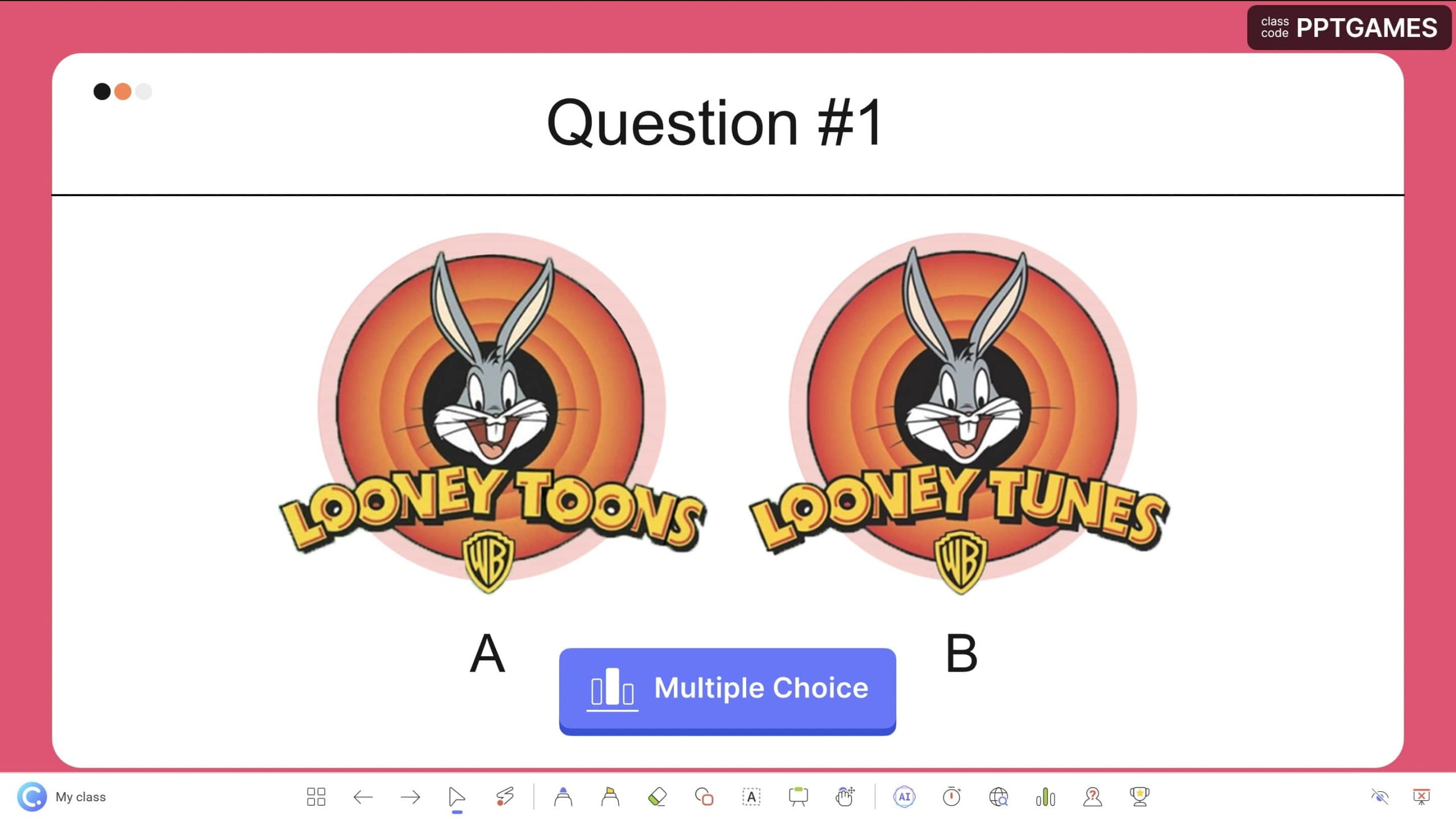
[Bonus] PowerPoint Game Template #5: Trivia Quiz
The PowerPoint game templates list would not be complete without a trivia quiz template. Prepare for an exhilarating twist that will leave your students spellbound. Brace yourselves with the list of exciting trivia questions from easy to difficult, all orchestrated by the ingenious interactive quiz question buttons seamlessly integrated in PowerPoint from ClassPoint. Participants can easily participate in your PowerPoint quizzes simply by using their device! As the participants embark on this mental showdown, you can effortlessly spice up the game atmosphere by awarding stars and revealing the leaderboard at the end of each round!
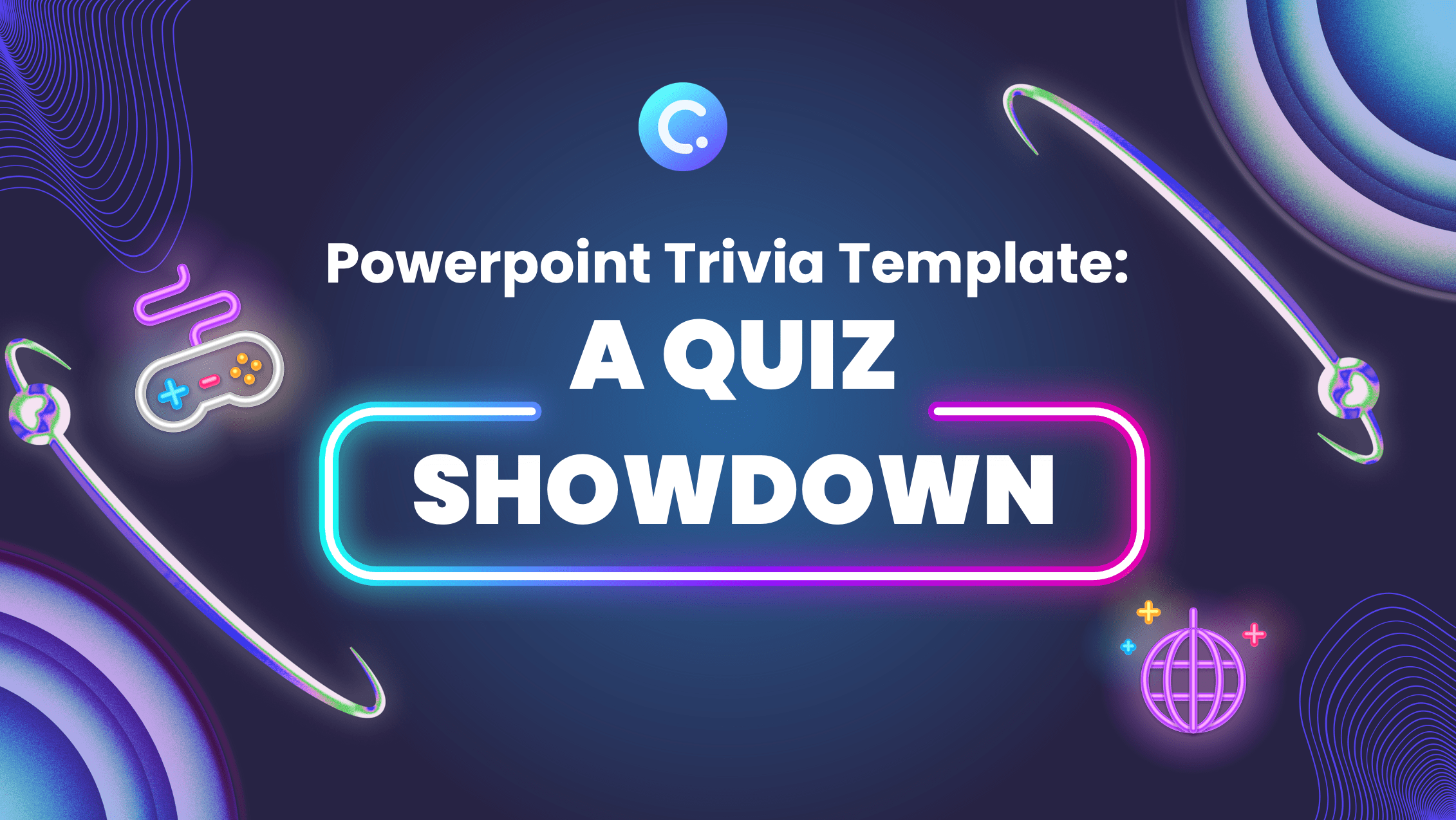
To ensure a smooth experience in using the above templates, make sure you have ClassPoint within your PowerPoint app! Don’t have an account yet? Sign up here .
And now, armed with our arsenal of PowerPoint game templates, you stand poised to usher your classroom teaching into an unparalleled realm of excellence and excitement! But, before you set forth on this transformative journey, we would like to let you in to one final secret , which allows you to turn these PowerPoint game templates into more powerful game adventures. Keep reading!
Elevating Your PowerPoint Games with ClassPoint
With the PowerPoint game templates alone, you will only be able to scratch the surface of interactive and gamified teaching. ClassPoint takes this playful and gamified learning to an entirely new dimension, turning your presentations into interactive adventures that engage, inspire, and educate like never before. We will share with you a myriad of ways on how you can make use of the ClassPoint integrated features in the PowerPoint game templates and easily turn any ordinary presentations into one-of-its-kind PowerPoint games:
- Interactive Quizzing
ClassPoint’s interactive quizzes integrated inside PowerPoint allow you to turn ordinary PowerPoint slides into captivating quizzes with a mere click. Thanks to ClassPoint’s magic, question buttons become gateways to engagement and game sessions in PowerPoint. Participants can easily join any of the interactive quizzes using their smartphones or devices, while the presenter collects the responses on PowerPoint effortlessly.
- Drag and Drop
The ability to drag and drop in PowerPoint is paramount for crafting captivating interactive games. Luckily, with ClassPoint’s Draggable Objects , you can turn your PowerPoint elements into draggable objects effortlessly. With ClassPoint’s ingenious Draggable Objects feature, your PowerPoint is bestowed with unparalleled flexibility instantly. It seamlessly transforms any elements within your presentation into draggable entities, allowing them to be manipulated effortlessly during Slideshow mode.
- Handy Slide Show Tools
Wave goodbye to mundane presentations and say hello to dynamic control. With ClassPoint wide range of presentation features , you wield the power to create interactive PowerPoint game experiences that astonish. Spin the wheel to randomly select names , orchestrate live inking sessions, and indulge in dynamic drag-and-drop activities – all while your audience is on the edge of their seats.
- Gamified Learning Journey
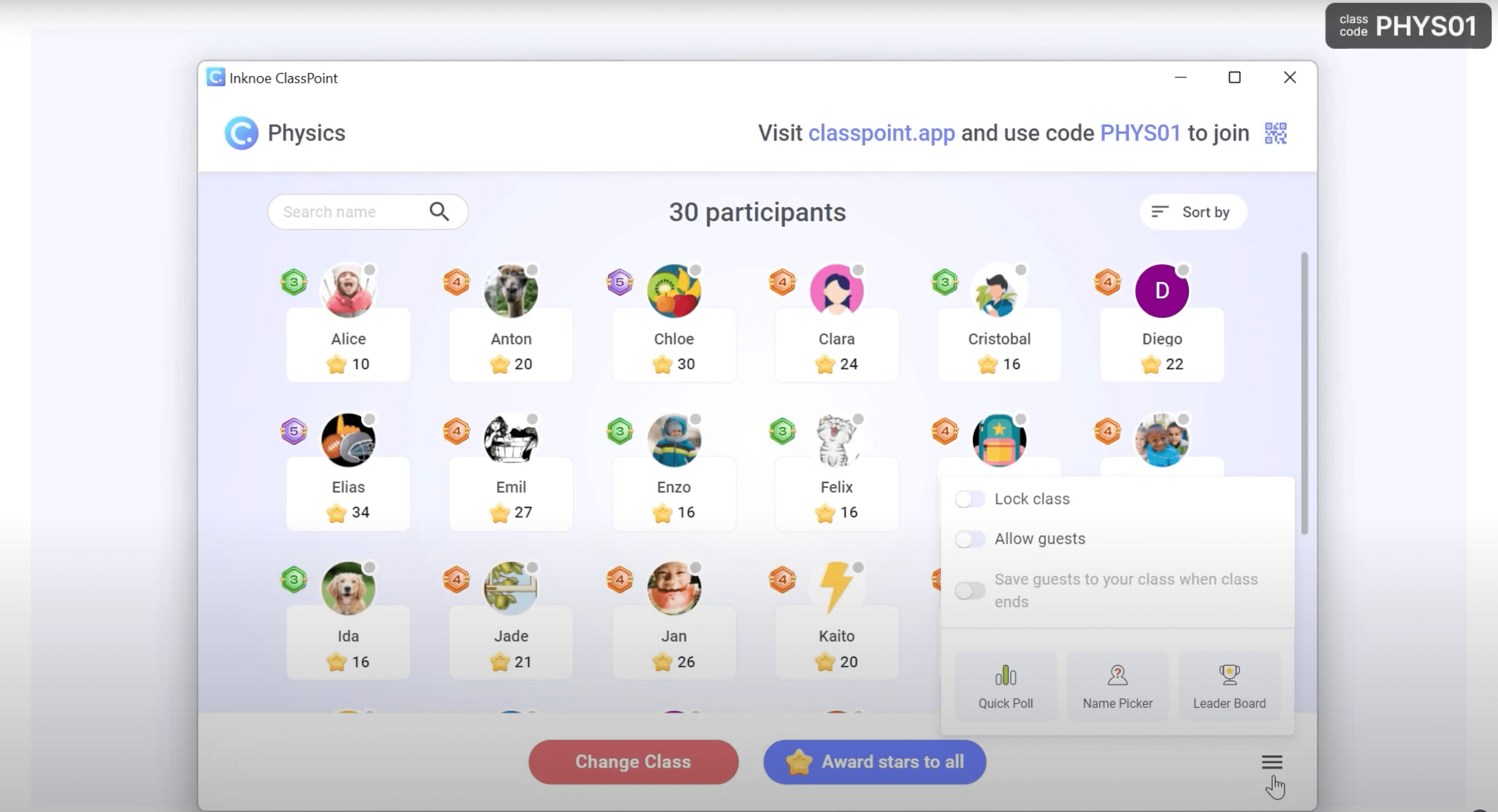
PowerPoint games reach new heights with ClassPoint’s star-studded reward system available in PowerPoint Slideshow mode. During PowerPoint games, you can award students stars , elevate them through levels , and watch as they proudly adorn badges of achievement. The competitive spirit soars as the in-built leaderboard paints a vivid picture of who’s ruling the knowledge arena.
- Student Performance Data
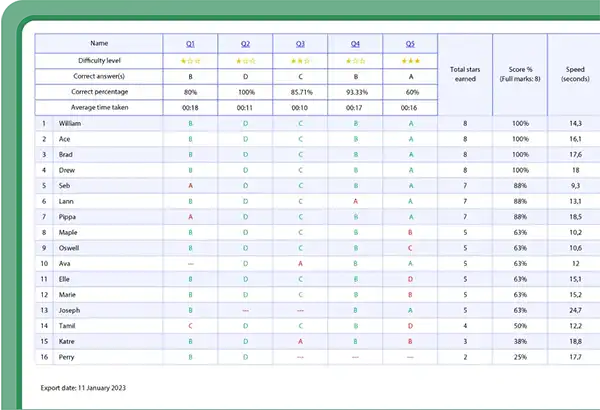
Let us not forget to keep track of student performance while we incorporate games into student learning. Luckily, ClassPoint is more than interactive bells and whistles. It is a data-driven ally, enabling you to track student performance with precision during PowerPoint games! Downloadable Excel reports and quiz summaries are available right at your fingertips to paint a comprehensive picture of your student progress.
- Real-time Game Feedback
No more waiting for post-game surveys. With ClassPoint’s quick poll , real-time feedback is your constant companion. Gauge understanding, adjust your approach, and make instant connections with your audience’s insights during or after your PowerPoint games!
The best part is — ClassPoint does not just play well with PowerPoint – it dances harmoniously within it. ClassPoint is seamlessly integrated with PowerPoint so you can turn any ordinary presentation slides into a game adventure instantly! No app-switching drama; just pure, uninterrupted focus on creating engaging content.
And so, we come to the end of our journey through the world of PowerPoint games and the magic of ClassPoint. This adventure has not only shown us the power of technology but also the incredible possibilities it brings to education. But more than just the technical aspects, remember the heart of it all – the excitement of discovery, the connections made, and the joy of learning something new.
Here’s to those “aha” moments, the animated discussions ignited by quizzes, and the sense of accomplishment that accompanies every step forward in learning.
Ready to take your PowerPoint games to the next level? Sign up for a free ClassPoint account now and embark on an educational journey where engagement knows no limits. Unleash the power of interactive design and gamification, and transform your presentations into captivating learning experiences that leave a lasting impact. Let’s make learning an adventure together!
Download All 8 Editable PowerPoint Game Templates
Engage your audience with these interactive PowerPoint Games. Customize the templates to fit your very own topic and presentation. The file includes templates for Interactive Quizzes, Family Feud, Wheel of Fortune, Memory, Hangman, Jeopardy, and a PowerPoint Puzzle!
About Ausbert Generoso
Try classpoint for free.
All-in-one teaching and student engagement in PowerPoint.
Supercharge your PowerPoint. Start today.
500,000+ people like you use ClassPoint to boost student engagement in PowerPoint presentations.
7 Audience Activities & Games to Play During Presentation
Transform your presentations into dynamic, interactive experiences with these 7 audience-engaging activities and games, fostering personal connection and knowledge exchange.
The stage doesn’t only belong to the speaker, but also to the audience. The audience isn’t any longer spectators only, they are also contributors. And this explains the importance of audience activities during presentation. Neuroscientists at Harvard found that talking about ourselves gives similar satisfying signals as money and food give us. Games to play, activities whereby attendees share personal experiences; it all contributes to an interactive experience. Not only that, when we’re able to foster the exchange of experiences and knowledge, then we also develop ourselves as individuals and organizations. So let’s zoom in on a number of audience participation ideas:
Key Takeaways:
- Engage audiences with 'Cross the Line' to visualize and explore diverse opinions and experiences.
- Implement 'Fishbowl Discussion' for in-depth, focused group conversations.
- Personalize interactions using 'Bring it On' for sharing significant items or songs.
- Employ the 'Talking Stick' method to ensure respectful, uninterrupted sharing.
- 'Knowledge Quiz' via Sendsteps.ai enhances learning and interaction on any topic.
- 'Set the Agenda' allows audience-driven content, creating tailored discussions.
- These activities and games enrich presentations by involving the audience actively and personally.
Audience participation ideas
Depending on the theme of your presentation, how formal or informal the setting is and how much time you have, there are several ideas out there to apply during your next presentation. Ask yourself during your preparation to what extend you still like to spend time on your PowerPoint, or whether you’d rather prepare for strong engagement activities?
Presentation Games
Presentation games are designed to motivate an audience to stay engaged with the speaker by inserting meaningful and fun additions to the presentation.
Cross the Line
“Cross the line” is a format known from “Challenge Day” whereby attendees are asked to stand, based on their answer (yes/no) on a question, either left or right from the room. With it differences are made visible and in the end sensible too. As such it can be one of the engagement games that have a big impact; either in a fun way or in a serious way. It will evoke laughter, recognition, surprise and a tear every now and then.
Ideas for questions are:
Who wanted to become a doctor when you were little?
Who was ever bullied at work?
Who prefers a city trip over a beach holiday?

Presentation Activities
There are many audience activities to think of when it comes to letting your audience speak up. In these three activities you’ll find back elements that will make your session personal allowing everyone to share their thoughts.
Fishbowl Discussion
In a fishbowl discussion there are two groups. One forms an outer circle and one group is seated in the middle. Only those located in the middle are allowed to talk. In the inner circle there’s always a free seat available. If someone from the outer circle likes to join, then the free seat is his/hers and somebody else should make space. You’ll therefore find that everyone’s contribution is very conscious and therefore often valuable. Everyone realizes that time spend in the inner circle is valuable: questions and contributions are to the point and well-thought over.

Bring it On
Ask your attendees in advance to bring a small personal item. During your session you let everyone (with a small group) elaborate on why the item is important to them. Alternatively you can do the same by asking your audience to bring a song along. This is a perfect activity to facilitate personal introductions within a group (e.g. upon the start of a new course).
The Talking Stick
The talking stick is an old Native American custom of talking. Upon the start of this activity, everyone should agree that whoever has the talking stick, is allowed to talk without interruption. It’s similar to the Fishbowl Discussion, but with the talking stick it’s not a group, but an individual talking. The talking stick can be any item, as long as it is neutral and not related to anyone in the group. Each time somebody is done talking, the talking stick should be put back in the midst of the group (and should not be handed over to somebody). It maybe sounds simple, but in practice this is a powerful method of creating deep communication and understanding.
Presentation Exercises
Next to games and other activities, these exercises also contribute to a lively presentation!
Knowledge Quiz
Before and straight after your presentation you can quiz your audience about your topic through Sendsteps.ai. With Sendsteps.ai, you can create interactive presentations with ease. Whether your topic is solar energy, hotel management, or 20th century art, the AI presentation maker allows you to formulate engaging multiple-choice questions and quizzes for your audience. Your audience can respond directly on their smartphones, and you can track who answered what and even announce a winner. With Sendsteps.ai, you can generate your quiz within minutes and engage your audience in a new and exciting way.

Set the Agenda
In your event program, you can leave part of the program blank. In it you eventually let your audience decide what to discuss. Upon the start of your session you let your audience form small groups. Give them a relevant question and use the output (which they can send in via Sendsteps) for a plenary discussion during your blank program item. From the output you can formulate statements that can result in a lively ‘agree’ or ‘disagree’ debate. Or alternatively invite adhoc a speaker to elaborate on the output. If you’re able to be this flexible, you’ll amaze your crowd with tailoring exclusively to their needs!
Related Blogs

How to Create Stunning Presentations with AI?

How to Create Engaging and Educational Quizzes

Exploring the Future of Online Quizzes with AI Technology

AI Presentation Makers A New Tool for Educational Success

How to Engage Your Audience with an Innovative AI Quiz Creator

The Impact of AI Quiz Tools on Data Collection and Audience Insights

The Benefits of AI-Powered Presentation Makers in Education
Leveraging ai for fun and engagement innovative uses of quiz generators.

Exploring the Top 5 AI Quiz Makers: Revolutionizing Knowledge Assessment
How can audience activities and games enhance a presentation.
Audience activities and games, such as 'Cross the Line', 'Fishbowl Discussion', 'Bring it On', and the 'Talking Stick' method, significantly enhance presentations by actively involving the audience. These activities foster personal sharing, respectful dialogue, and group engagement. They also encourage audience members to contribute their perspectives, making the presentation more dynamic and inclusive. Utilizing tools like Sendsteps.ai for interactive quizzes and allowing the audience to set part of the agenda further personalizes the experience, making it more engaging and relevant. Such interactive methods transform presentations from passive listening to active participation, enriching the overall experience for both the presenter and the audience.
How do these interactive activities impact the overall effectiveness of a presentation in terms of audience engagement and retention of information?
Interactive activities in presentations enhance audience engagement and retention of information by making the session more dynamic and participatory. This active involvement can lead to better understanding and recall of the presented material.
Can these activities be effectively used in various types of presentations, like formal business meetings or educational lectures?
The effectiveness of interactive activities varies with the type of presentation. While they are commonly seen in educational and informal settings, their use in formal business contexts should be carefully considered to maintain the appropriate tone.
How to gauge and measure the success or impact of these interactive activities on the audience?
Measuring the success of interactive activities can be done through immediate audience feedback, post-presentation surveys, and observing the level of audience participation and response during the activity.

Anouk Baltus
Anouk’s passion for presenting started when she was very young: from voluntarily giving presentations in primary school to winning a speaking award with a self-written and presented speech. This adoration comes to life while working for Sendsteps. A passion for giving and writing speeches turned into writing blogposts about these subjects to help others find their passion in presenting.

150+ Unique Topics For Presentation in College
Team Desklib
Published: 2022-10-17

It might be challenging to come up with presentation topic ideas that are significant, pertinent, and have a unique approach. You're in the right place if your teacher or professor just gave you a presentation assignment and instructed you to choose your own topic.
Presentation talents are important outside the confines of the lecture hall at college or the classroom at school. Since businesses value employees with strong communication and presentation skills, students constantly look for motivational presentation topics for their academic assignments. They cover a variety of topics and are ideal candidates for commercial negotiations. They are also excellent supervisors since they have good interpersonal skills. Students are always encouraged to improve their communication abilities and develop engaging ways to present their ideas.
We've compiled a collection of insightful and compelling presentation topic suggestions for various disciplines in this blog -
Ideas for Education Presentation Topics
- The advantages and disadvantages of Online Classroom
- Describe dyslexia.
- What is The Pythagorean Theorem?
- Is it worthwhile to attend college?
- Is reading on Kindles better than the paperback?
- What is global education?
- Describe unschooling.
- Why are teachers paid so little?
- Describe sociology .
- Describe anthropology.
- Social archaeology: What is it?
- Why are mentorship programs necessary in schools?
- What kind of education is offered in Finland?
- What exactly is Montessori education?
- Who is Rudolf Steiner?
- What language is the most challenging to learn?
- Describe An Ivy League institution
- Describe the SAT.
- Describe the TOEFL.
- The IB program is what?
- How to enrol in a foreign university
- How do learning disabilities work?
- What is a Gap Year?
- Why is learning a second language important?
- What does an international exchange program entail?
- Why is studying physics important?
- Why is reading good for the brain?
Health-related ideas for presentation
- What you should know about COVID-19
- How does the immune system in humans function?
- How does the respiratory system work?
- How do illnesses spread?
- What is the mechanism of the nervous system ?
- Describe skin cancer.
- What are Infectious diseases?
- When should you contact 911?
- The placebo effect: what is it?
- How to interpret a food label
- How to maintain a healthy diet
- What is CPR?
- Taking care of a wound
- The definition of Alzheimer's disease
- How does dry drowning work?
- How do allergies work?
- Why do cigarettes harm your health?
- How are medications deemed safe for eating by humans?
- Why ought marijuana be made legal?
- What is the work of a neurosurgeon?
- What is an EMT?
- What is the mechanism of digestion?
- What changes do antidepressants make to the human brain?
- Generalized Anxiety Disorder (GAD): What is it?
- How real is Depression and how is it affecting people adversely?
Ideas for History Presentation Topics
- Dinosaur history from prehistoric times
- Which American president is your favourite?
- The status and position of women in society in today’s day and age.
- Who was Alexander the Great ?
- What is the Independence Declaration?
- Who was Harriet Tubman?
- Describe Pangea.
- Describe Gobekli Tepe.
- Describe the achievements of Nelson Mandela.
- The Berlin Wall: What is it?
- What causes a tsunami on Boxing Day?
- Who were The Conquistadors?
- Who were The Incas?
- Why is Thanksgiving celebrated?
- Who was Pocahontas?
- What is the language's genesis?
- How were mummies from Egypt preserved?
- What is the background behind the King Tut curse?
- What was the Ottoman Empire comprised of?
- What was the world's very first civilization to appear?
- What are the main tribes of Native Americans?
Topics for Life Skills Presentations
- Tire changing techniques
- What are the fundamentals of cooking?
- How to wash clothes
- How to set up a monthly budget
- A good morning routine is what?
- What tools are necessary for a household?
- The capability of arranging a house on a budget
- How to operate a vehicle
- How to cut costs
- How to look after a baby
- How to look after a plant
- How to swap out your AC filters
- How to use plastic less effectively
- How to avoid generating trash
- Ability to cook for oneself
- How to quickly clean a home
- How to correctly browse for something on the internet?
- Why is it crucial to impart computer literacy to our grandparents?
- Dressing appropriately at a funeral
- Creating a first-aid kit at home
- What exactly is emotional IQ?
Ideas for Media Presentations
- The development of projectors
- How could using social media be risky for young people?
- The development of the internet
- The Marvel Cinematic Universe: What Is It?
- The person Steve Jobs.
- Who was the television's inventor?
- What happened initially, VH1 or MTV?
- What is Virtual reality?
- What is Augmented reality?
- The development of cinema and film
- How are TV ads created?
- What does an art director do?
- What kind of media representation do minorities get?
- In what ways are women portrayed in the media?
- Why do people blog?
- Who was Elvis Presley?
- The development of jazz
- The Tango's history
- What's the job of a social media manager?
- What is Content marketing?
- What does influence mean?
- How has binge-watching impacted television?
- TikTok's effect on advertising
- What is the theory of agenda-setting?
- Public relations in the digital age
Ideas for Science Presentations
- What is Artificial intelligence (AI)?
- How do GMOs work?
- Why is organ donation essential and what is it?
- How does the breathing system function?
- Should it be legal to clone humans?
- The greenhouse effect is what?
- Why do some individuals claim that global warming is a hoax?
- How does the water cycle work?
- How does photosynthesis work?
- What variations of matter are there?
- How is a medication created?
- Alternative medicine is what?
- Describe biochemistry.
- What is Quantum physics?
- What is The Big Bang Theory?
- Fifty years since the moon landing, how does it impact us today?
- What is the cycle of a plant?
- How are children born?
- A particle accelerator is what?
- Describe a light-year.
- Why do people desire to settle on Mars?
- Why is Pluto not a planet anymore?
- Why do wildfires start?
Ideas for Presentations on Work and Life
- What is the salary disparity?
- The job of an entrepreneur?
- How does a franchise operate and what is it?
- What professions pay the best?
- Why should moms be rehired into the workforce?
- Does paternity leave make sense for fathers?
- Do internships have any value?
- Why are more college-age students using skilled labour to join the workforce?
- Why is having a summer job vital for high school students?
- What is a glass ceiling and what does it signify?
- How to live a digital nomad lifestyle?
- How to put an end to prejudice at work?
- What is a Candy Striper?
- Does volunteering harm those in most need?
- The meaning of "the 9 to 5".
- What qualities make for a healthy work-life balance?
- When should mothers resume their jobs?
- What to wear to a job interview
- Writing a resume or CV
- Making an infographic
- How safe is working as a freelancer in 2021?
- How has COVID-19 affected organizational culture?
- Are cover letters important to employers?
Ideas for Literature Presentation Themes
- Who was Shakespeare and what does his work signifies?
- Describe Haiku.
- What is the subject of The Catcher in the Rye?
- Who was Dante Alighieri?
- Describe a sonnet.
- What is Magical realism?
- Who was Emily Bronte and what does her work signifies?
- How is 1984 still relevant today?
- What distinguishes an autobiography from a memoir?
- What novel, if any, deserves to be adapted into a motion picture?
- Describe Oscar Wilde.
- Who was Orhan Pamuk?
- Describe Isaac Asimov.
- What is Historical fiction?
- Greek tragedies—what are they?
- The hero's journey: what is it?
- Who was Ulysses?
- Where does science fiction literature come from?
- My top ten all-time favourite classic books
- Who were The Brothers Grimm?
- Ernest Hemingway lived an interesting life.
Ideas for General Cultural Presentation Topics
- Does graffiti qualify as art?
- Greek myths in contemporary media
- Why should students study several religions?
- How do crop circles work?
- Describe Area 51.
- Where does rock & roll come from?
- What kind of music festival was Woodstock?
- 10 unique features of any nation
- What does it mean to live "off the grid"?
- What is Crossfit?
- What is Cultural appropriation?
- What is Feminism and what is its importance in today’s day and age?
- What distinguishes White Hat from Black Hat hacking?
- Who is the musician whose stage name was Prince?
- Why is yoga such a hit?
- How does art therapy work?
- What distinguishes parenting in the 1980s from parenting today?
- Describe a journalist.
- What does "generation gap" mean?
- Who are the polyglots?
Conclusion -
The conclusion of your presentation provides a summary of its goals. Here, you can summarise your research, present your viewpoint, or influence people's opinions on a certain subject. The conclusion is typically disregarded or given little weight. This is completely incorrect because the discussion is wrapped up in the conclusion. When you're finished, thank your audience and make an open invitation for questions.
More Reading:-
- 150+ Good Debate Topics for Students
- 100+ Good Argumentative Essay Topics and Ideas
- 100+ Best Compare And Contrast Essay Topics (2022)
- Top 240 Biology Research Topics for Students in 2022
- How to Choose a Research Topic?
- Top 50+ Research Topics for High School Students in 2022
Your Feedback matters
- Teaching Tips
25 Classroom Icebreakers For College Professors [Plus: Free List of 50 Icebreakers]
A roundup of the best classroom icebreakers to help students connect and collaborate in any course
Vawn Himmelsbach
![presentation activities for college students 25 Classroom Icebreakers For College Professors [Plus: Free List of 50 Icebreakers]](https://tophat.com/wp-content/uploads/Icebreakers-blog.jpg)
Classroom icebreakers encourage new college students to have conversations, getting to know you and each other in the process. Used early on, icebreakers can help students feel comfortable in your classroom or team meeting. They’re ideal for the first day of school, but can be used throughout the semester and serve as a precursor for teamwork and collaborative learning. Virtual icebreakers —facilitated via social media, discussion boards or in virtual team meetings—have also gained new meaning in helping group members warm up to one another.
A classroom icebreaker for college students can be as simple as asking learners to introduce themselves to the class or to the students sitting next to them, but games and activities offer a chance to interact with a greater number of classmates and build camaraderie. According to a guide 1 from Nottingham Trent University, for classroom icebreaker games “there ought to be a fun aspect to the activities in order to provide participants with some shared history that they can discuss later and, where possible, a relevance to the taught course/university experience.”
It’s no doubt that icebreaker activities like scavenger hunts or Pictionary are overdone. Keep in mind that some classroom icebreakers for college students could be awkward or uncomfortable, such as publicly sharing personal information. The key is to get students talking to each other, having conversations and making connections—without social risk. This could mean facilitating small group activities versus requiring students to share personal information in front of the whole class. As an educator, help your students get to know one another in a safe and effective way.
Here are 25 fresh and easy-to-implement games and activities to break the ice in your in-person, blended or online classroom.
Do wnload The Ultimate List of Icebreakers for the College Classroom for an additional 50 activities and fun icebreakers (get the list here ).
Table of Contents
7 group games for college students (with fun icebreaker questions).
- 7 first day icebreakers
- 6 course- or assignment-specific icebreakers
5 good icebreaker questions to engage college students in your classroom
1. concentric circles.
This is a great team-building icebreaker for an in-person learning environment. Arrange students in two circles, one inside the other, with students facing each other in pairs. Ask a fun icebreaker question, such as “what’s your favorite thing about college and why?” Pairs discuss the answer, then rotate the circle to form new pairs for the next question—exposing students to the different perspectives of their peers. The trick is to provide open-ended questions rather than those with a ‘yes’ or ‘no’ answer to get students talking.
2. Find someone who…
This is like Bingo, but with people instead of chips. Students are given a piece of paper with a grid of squares. Written inside each square is an item, such as ‘travelled to another continent’ or ‘has a younger sister.’ Students are given a time limit to find classmates who fit the description. Whoever gets ‘Bingo’ first wins. You can even award a prize of your choice, such as a bonus point or two on an upcoming assignment. This is a good classroom icebreaker to help your college students warm up to one another at the start of the school year—especially those who are meeting one another for the first time.
3. Name game
This classic party game can also be applied in the classroom—you can even tweak it to reflect the curriculum. Write down names of famous people (or names related to course material) on sticky notes. Students place a sticky note on their forehead and interact with their classmates, asking fun icebreaker questions to understand which person they are embodying. This team icebreaker helps students loosen up and informally interact with their classmates. It also helps them learn about a figure who may have previously been unknown to them.
4. Poker hand
This classroom icebreaker for college students is ideal for large groups (a maximum of 50). Shuffle a deck of cards and hand out a card to each student. Set a time limit and instruct students to find four classmates and form a hand of poker. The best hand ‘wins’ when their time is up—consider offering a couple of bonus points on an assignment. Keep in mind that not everyone knows how to play poker, so display the rules of the game on a whiteboard or a slide at the front of the classroom. This activity may help students develop their analytical skills.
5. Three of a kind
Set a time limit and instruct students to find three other students they share something in common with—though not anything obvious or visible, such as hair color. The idea is to help them make connections that may not be immediately apparent. For more strategies to help your students get to know their classmates, download our free list of college icebreakers here .
6. Find your pair
In advance of class, prepare word pairs—such as salt and pepper, or ketchup and mustard—on separate pieces of paper. Have students select a piece of paper from the pile, ensuring they don’t share their word with anyone else. Students then walk around the room and ask yes or no questions to their peers to try and figure out what word they have (and helping them get to know more people in your class). Once students have figured out what word they have, they then must find their pair (if they haven’t already) by continuing to ask fun icebreaker questions.
7. Act and react
Ask students to write down an event or scenario on a piece of paper. These may range from “I just got fired from my job” to “I just got stung by a bee.” Fold the pieces of paper up and put them in a bag or hat. Have students randomly draw a slip of paper and react to the experience using their facial features, gestures or words. The remaining students can guess what just happened. This activity will help lighten the mood in your class and allows for student-student interaction.
→ Download Now: 50 Free Icebreakers for College Courses
7 first day icebreakers for college students
8. two truths and a lie.
Divide the class into small groups. Each group sits in a circle, and each participant tells their group three statements; two are true and one is a lie. The other students in the group must guess which is the lie. This interactive icebreaker could be used during the first day of class to make introductions and reduce first-day jitters, all by sharing fun facts with one another.
9. This or that
Present students with a choice between ‘this or that.’ Topics should be relatively light, such as whether they prefer dogs or cats (though you could also tie this back to course material). Students move to the side of the room that reflects their choice. After a few minutes, encourage one or two members in each group to defend their position amongst a new group of students. Ask students to repeat this process for several rounds to help familiarize themselves with a variety of standpoints. Similar to would you rather, this or that is ideal for small or large groups and spurs conversations and makes connections.
10. Longest line
Instruct students to form one continuous line based on certain criteria, such as alphabetically by first name or from shortest to tallest. For large classes, you could ask students to gather in groups based on some commonality (such as by birthday month). The goal is for students to line up as fast as possible—a result of clear and open communication in medium-sized groups. This classroom icebreaker for college students is a great team-building activity and can help create a sense of community should it be used as a first day icebreaker or at the beginning of the year.
11. Three Ps
Divide students into small groups, and have them share three facts about themselves: something personal, something professional and something peculiar, such as an interesting hobby or habit. This icebreaker idea can easily be used in virtual meetings. It should be noted, the personal fact shouldn’t be anything too personal—it could be something as simple as a country they’ve always wanted to travel to. Use this great icebreaker when students go back to school from the summer, helping them warm up to their peers.
Get an additional 50 activities and fun icebreakers here
12. Beach ball
Like the name suggests, this activity requires an inflatable plastic beach ball. Ahead of class, write different get-to-know you questions on each segment of a beach ball using a Sharpie. Arrange students in a circle. For larger classes, you may want to divide the class into smaller groups. The fun icebreaker questions could be “what was one of your highlights from the summer?” or “who is your celebrity idol and why?” Toss the ball. Whoever catches it asks the question closest to their left thumb, answers it and then tosses the ball to another student.
13. Syllabus questionnaire
Before sharing your syllabus with students, place them into groups of five and have them fill in a Google Doc or worksheet with questions they have about your course. Structure the first five minutes as a brainstorming session. After each group has prepared their list of questions, distribute the syllabus and have students find answers to their questions using this document. Re-convene as a group and give students an opportunity to ask any further questions that couldn’t be answered from the syllabus. You may also wish to facilitate this activity using individual lesson plans throughout the semester.
14. String a story
Arrive to class with a big roll of yarn or string and cut various pieces ranging from five to 20 inches in length. Bunch the pieces of string together and place them to the side. Have each student draw a piece of string from the pile and slowly wind it around their index finger. As they are winding the string around their finger, students must introduce themselves and give a first-person account of their life—in whatever capacity they wish—until the string is completely wound up.
6 course- or assignment-specific icebreakers for college students
15. blind contour.
This activity is a fun way to get your visual arts students talking in a small group of people. Split students into groups of five and have each student choose an object to sketch—without looking at their paper. Give students five minutes to complete their sketch, then have them share it with their team members and ask the remaining students to guess what they drew. Repeat the process with another item or object, until time runs out. This game helps hone students’ observational skills, while making sure students are mentally present.
16. It was the best of classes, it was the worst of classes
This classroom icebreaker not only helps students relate to each other, it can help inform your teaching practices throughout the term. On one side, write “the best class I ever had” and on the other side, write “the worst class I ever had.” Without referring to specific professors or courses, ask students to share what they liked and disliked about their previous courses. Make a list of these items to potentially implement—or avoid—in your own course this semester. Additionally, consider using an anonymous discussion board or a group worksheet in your virtual classroom to encourage participation.
17. The living Likert scale
This icebreaker question for college students lets learners see where they—and their peers—stand on a variety of topics related to your discipline. Before class, write numbers ‘1’ through ‘7’ on pieces of paper and place them across the room. The sheet with ‘1’ on it could refer to ‘strongly disagree’ while ‘7’ might refer to ‘strongly agree.’ Acting as a facilitator, pose a series of statements related to your discipline—such as “I think television can make children act aggressive” in a social psychology class—and have students move to the side of the wall according to their stance. Students who are comfortable sharing their opinions pertaining to the topic may do so.
18. Why am I here?
Have students draw a picture that represents why they enrolled in your course. Encourage them to think beyond the fact that they may need your course credit to graduate, or that their high school guidance counselor recommended your course. They could think about wanting to learn more about your field or simply that their friends were enrolled in your class, too. After five minutes, have students share their picture with the larger group if they’re comfortable—helping students feel like part of one interconnected community.
We have more classroom icebreakers for college students here
19. Class in one word
Have students share their perceptions of your discipline in one word, such as ‘complicated,’ ‘analytical,’ or ‘enjoyable.’ Students can go around in a circle—or the order they appear in your Zoom tile view—and describe their past experiences in your field using a single word. In an asynchronous course, set up an anonymous discussion question in Top Hat and have students respond on their own time. This activity offers a humanizing view of who else is in the same boat.
20. Philosophical chairs
A statement that has two possible responses—agree or disagree—is read out loud. Depending on whether they agree or disagree with this statement, students move to one side of the room or the other. After everyone has chosen a side, ask one or two students on each side to take turns defending their positions. This allows students to visualize where their peers’ opinions come from, relative to their own.
Classroom icebreakers aren’t just a ‘feel good’ exercise. The best icebreakers can help students create connections and build a sense of camaraderie in your classroom. It can also help educators get to know their students and build better relationships. Whether you’re in a physical classroom or in a remote team setting, the above icebreakers will surely create a light-hearted environment for your students to thrive in.
As Jennifer Gonzalez explains on her website, Cult of Pedagogy, 2 , “building solid relationships with your students is arguably the most important thing you can do to be an effective teacher. It helps you build trust so students take academic risks, allows you to better differentiate for individual needs, and prevents the kinds of power struggles often found in poorly managed classrooms.”
21. Dream dinner party
Ask students: If you could invite any three people, living or dead, to a dinner party, who would they be and why?
This question allows students to share their interests, values, and the historical or influential figures they admire. It can spark interesting conversations and provide insights into each student’s personality.
22. Bucket list sharing
Ask students to share one item from their bucket list. This can range from travel destinations to personal goals. It helps students discover shared interests and aspirations, fostering connections based on common goals.
23. Memory lane
Ask each student to share a significant or memorable experience from their past, such as a favorite childhood memory, a significant achievement, or an interesting travel story. This allows students to open up about their lives in a positive way.
24. Favorites icebreaker
Ask students to share their favorites, such as their favorite book, movie, food, or vacation spot. This simple icebreaker can reveal common interests among students and provides an easy topic for conversation.
25. Superpower scenario
Ask students, if they could have any superpower, what would it be and why? This question adds a creative and imaginative element to the discussion, and students can explain the reasoning behind their choice, providing insights into their personalities.
Download The Ultimate List of Icebreakers for the College Classroom, packed with 50 easy-to-implement games and activities for your next course. Get the full list of activities here .
Related stories
- Six small group games for college students
- The pros and cons of the high tech classroom
- Ice-Breaker Activities to use in Your First-Year Student Induction. (n.d.). Retrieved from https://www4.ntu.ac.uk/adq/document_uploads/running_a_course/193397.pdf
- Gonzalez, J. (2017, July 23). A 4-Part System for Getting to Know Your Students. Retrieved from https://www.cultofpedagogy.com/relationship-building/
Recommended Readings

25 Effective Instructional Strategies For Educators

The Complete Guide to Effective Online Teaching
Subscribe to the top hat blog.
Join more than 10,000 educators. Get articles with higher ed trends, teaching tips and expert advice delivered straight to your inbox.
Are you seeking one-on-one college counseling and/or essay support? Limited spots are now available. Click here to learn more.
60 Team-Building Activities for Kids & Middle/High School Students
May 31, 2024
Collaboration and communication are essential skills that students develop throughout their childhood and teenage years. You can help your students learn these skills by introducing team-building activities, which offer opportunities to collaboratively complete tasks, bond over mutual interests, and accomplish goals together. Below you can find 60 team-building activities for kids in elementary school as well as middle school and high school students. These can be great for building a sense of community in classes, as well as in clubs, performance ensembles, and sports teams.
Team Building Activities for Kids
1) Have your students create an age line-up, in which they organize themselves from oldest-to-youngest by walking around the room and sharing their birthdays.
2) Give the same instructions with height, shortest-to-tallest. This can also be done in silence to encourage silent communication.
3) Do a hula hoop pass, in which students join hands in a circle and pass a hula hoop all the way around, stepping through without unclasping their hands.
4) Build food towers in groups, with students competing to build the highest towers with foods such as dried spaghetti, marshmallows on toothpicks, graham crackers, and candy.
5) Put blue, green, and yellow spots on the foreheads of your students, and have them find each other’s “color teams” without speaking. This is a great exercise for nonverbal communication.
6) Have students talk in groups and find a “common thread,” or something they all have in common (from having older siblings to liking ice cream). Afterwards, they can come up with a team name based on this commonality.
7) Have a “show and tell,” in which each student brings in an object or toy that’s important to them.
8) Make a “human alphabet,” in which students work in groups to create each letter of the alphabet with their bodies.
9) Give 20 seemingly unrelated objects to groups of students and have them work together to classify the objects into categories. Once the time is up, have them explain their rationale to the class.
10) Try a game of two-way or four-way tug-of-war, depending on how many students you have.
Team Building Activities for Kids, Middle School, and High School Students (Continued)
11) Play “knot and unknot,” in which students hold hands in a circle and twist and turn under each other until they’re all tangled up, and then they work together to untangle themselves.
12) While you’re at it, play a classic game of Twister, but with the goal of helping the other players keep from falling.
13) Play team tic-tac-toe using 9 hula hoops set up as a tic-tac-toe board. Students can throw different colored bean bags as X’s and O’s.
14) Play “hot and cold” by having a student leave the room while others hide an object. When the student comes back, they look for the object guided by the words “hot” (if they’re near) and “cold” (if they’re far).
15) Create a “floor as lava” obstacle course that students must help their teammates through, or complete as a team relay race.
16) Have students guide each other through a set of obstacles blindfolded in order to teach trust and responsibility.
17) Create a class tradition to begin or end class that involves stretching together, giving each other compliments, or giving high-fives on the way in or out.
18) Work together to decorate a class bulletin board for each season.
19) Do a “mirroring” exercise with a partner, in which one partner moves and the other must be their “mirror,” and then the roles switch. For a more difficult exercise, have them do this while moving across the room (this can also help teach spatial awareness).
20) Do a balloon relay race, in which partners must hold a balloon between their stomachs or backs while racing.
Team Building Activities for Middle School Students
21)Have a compliment circle, in which students sit in a circle for 5 minutes and shout out compliments to others in the circle.
22) Create a scavenger hunt with math or trivia clues that students must complete in small groups.
23) Give a bag with five items to different groups. Then, have the groups work in teams to make and perform skits using the items.
24) Organize a “three-question mingle” session, in which each student writes down three questions on a post-it, and then students pair up and ask each other their questions. After a timer rings, the two students exchange post-its and repeat with different partners.
25) Draw “life maps.” Students draw out maps of their lives as though it were a board game, and then present their maps to small groups.
26) Do a “photograph show and tell,” in which each student brings a photograph that’s important to them and presents it to a small group, as the others ask curious questions about the photograph.
List Continued
27) Have a newspaper fashion show, in which students use old newspapers, tape, and other materials to create high-fashion costumes for one person in each group. This activity encourages sustainability and “upcycling,” in addition to collaboration.
28) Do a paper chain race. Each team works with construction paper of a different color to create a paper chain. Whichever team creates the longest chain, after a certain amount of time, wins the race.
29) Play “getting to know you” bingo, in which students must ask each other questions to fill out a bingo sheet with their classmate’s names. The bingo slots can say things such as “has an older sibling” or “plays on a sports team” or “likes spicy food.”
30) Set up a gallery of student projects, and organize a tour so that others from outside the class can come visit the gallery. Your students can work together to organize a tour order, welcome and closing speeches, and a Q&A session.
31) Play Pictionary : one partner pulls a word, and must convey it to their partner by drawing.
32) Do an egg drop challenge , in which each group must come up with strategies for dropping an egg out the window without it breaking. This could be perfect for a STEM class.
33) Organize a class trash cleanup around the school.
34) Organize a class book swap.
35) Come up with a collective group tradition for beginning or ending class. Maybe this involves doing shout-out compliments, secret handshakes, or stretching together in a circle.
36) Collaboratively create a music playlist with your students that can play during breaks or to begin and end classes.
37) Create a class play based on a book you’re reading, and ask different students to direct different scenes, design costumes and sets, etc.
38) Have students collaboratively design a restaurant with a theme from the class, including menu items and decorations.
39) Ask a class of 8th graders to work together to design a lesson for a class of 6th graders, or for a local elementary school class. This can help students to bond with each other and other grade levels, while also empowering them to feel mature and ready for high school.
40) Create “strength cards” for each student, which get passed around the classroom. Students write the strengths and other admirable qualities of each student on the card with their name. Each card is returned to the student as a keepsake and a positive reminder.
Team Building Activities for High School Students
41) Ask your students to walk around the room, then choose two others to track (without them knowing). Then, each student moves around, trying to create an equilibrium triangle with the other two they are tracking. The game ends when everyone stops moving in their equilibrium triangles. This is more difficult than it may seem.
42) Replicate an episode of “Shark Tank,” by having groups of students work together to design, present, and sell a product to a group of judges.
43) Play “Two Truths and a Lie” in small groups.
44) Play “partners Two Truths and a Lie,” in which two students get to know each other with icebreaker questions, and then each student creates two truths and a lie about their partner for the group.
45) Have a weekly “lunch and learn,” in which a student or two teach a mini lunchtime class about a skill that has nothing to do with your academic class, such as knitting, cooking, or stand-up comedy.
46) Solve 100-to-500-piece jigsaw puzzles in small groups.
47) Have a “show and tell” with outside hobbies or projects the students are working on, which have nothing to do with the class material.
48) Organize a “ Socratic Seminar .” This discussion format emphasizes careful listening and question-asking over trying to prove a point or win an argument.
49) Make concentric circles, an inner and an outer. Pair the student on the inner with the student closest on the outer, ask a question about course material, and have them discuss. When the time is up, the circle rotates and another question is posed.
50) Do the same concentric circles, but with outlandish or fictitious prompts that the students need to create answers for (for example, “What if gravity didn’t exist?” or “What if the historical event __________ never happened?”)
51) Play “this or that,” in which students can agree, disagree, or remain neutral on a variety of political statements or issues. Then students can discuss the issues in small groups in a manner that encourages questioning and listening, rather than proving the other wrong.
52) Allow the class discussion to become personal by dividing students into groups to talk about how a lesson affects their lives. This is a great way to process information and bond while they’re at it. Some question examples could be: Which character in the book do you relate to? How does climate change affect your everyday life? What is the personal impact of [name historical event]?
53) Have your class or student group organize an event together, such as a performance, gallery opening, presentation series, or charity event. They can take on roles for organizing (social media, communications, setup/breakdown, tech needs, introduction, food/drinks, etc.)
54) Play a version of Pictionary but with course material. One partner pulls a word or concept and must convey it to their partner by drawing it or explaining it without using the word itself.
55) Do a service-learning project together, such as picking up trash in a park or spending a day doing art with elders at a retirement home,
56) Organize a class party for a holiday. Have students contribute different food items and plan activities.
57) Have your students come up with a group ritual for ending classes or club meetings, such as giving high fives, doing shout-out compliments, or reciting a goofy song or chant.
58) Have a trivia day based on lesson material, in which students must come up with answers as groups to win points.
59) Have a book club for outside reading, in which students decide with their groups on the books. They meet weekly to discuss a few chapters at a time, and they give a presentation to the class after the book is complete.
60) Ask students to collaboratively imagine and design theme parks based on course material. Each group presents to the class at the end.
Additional Resources
As you can see, there are seemingly endless possibilities for introducing team-building activities to your students, whether you teach kindergarten class or high school history, or whether you direct school theater rehearsals or coach basketball practice. Remember that you can adapt any of these activities for the grade-level you’re working with. For more inspiration related to classroom activities, check out the following articles on icebreaker questions for students , weird facts to share , 150 Journal Prompts for Students , and last day of school activities
- Teacher Tools
Sarah Mininsohn
With a BA from Wesleyan University and an MFA from the University of Illinois at Urbana-Champaign, Sarah is a writer, educator, and artist. She served as a graduate instructor at the University of Illinois, a tutor at St Peter’s School in Philadelphia, and an academic writing tutor and thesis mentor at Wesleyan’s Writing Workshop.
- 2-Year Colleges
- Application Strategies
- Best Colleges by Major
- Best Colleges by State
- Big Picture
- Career & Personality Assessment
- College Essay
- College Search/Knowledge
- College Success
- Costs & Financial Aid
- Data Visualizations
- Dental School Admissions
- Extracurricular Activities
- Graduate School Admissions
- High School Success
- High Schools
- Homeschool Resources
- Law School Admissions
- Medical School Admissions
- Navigating the Admissions Process
- Online Learning
- Outdoor Adventure
- Private High School Spotlight
- Summer Program Spotlight
- Summer Programs
- Test Prep Provider Spotlight
“Innovative and invaluable…use this book as your college lifeline.”
— Lynn O'Shaughnessy
Nationally Recognized College Expert
College Planning in Your Inbox
Join our information-packed monthly newsletter.

IMAGES
VIDEO
COMMENTS
This activity is also free for up to 10 people and is easy to personalize. . 6. The Get to Know You Game. This activity is one of the best presentation games if you have a small group that doesn't really know each other. The Get to Know You Game is a creative way to do introductions, and it's really simple.
Here's the good news: no need for an all-nighter. Beautiful.ai can help you nail your college presentation in a pinch. The ease of use, and intuitive controls, help you create something brilliant in minutes, not hours. Start inspired with our inspiration gallery of pre-built templates and customize them to fit your content.
1. Shark Tank. Shark Tank is a great interactive team building game for college students. This is a great way for students to show off their leadership skills, presentation skills and creativity. Similar to the Shark Tank TV show, students in small groups will come up with a product, a pitch and a presentation.
Here are 20 interactive activities to harness the power of PowerPoint in your classroom. 1. Play Snapchat Games. When I first saw some of these Snapchat games — specifically "Would You Rather," "This or That," and "My Face When," I immediately thought of how it could be used in class!
10. The never-ending sentence. The never-ending sentence is a great game that incorporates many of your attendees and awakens their brain cells. It is perfect for keeping up their engagement and interest, especially for long presentations or workshops when you feel like some people are getting a little tired.
Focus on your posture, hand movements, facial expressions, and any other nonverbal cues you use while speaking. By actively observing yourself in the mirror, you can identify areas for improvement in your delivery and work on refining your public speaking skills over time. 4. Storytelling Practice:
Try not to hurt others while using humor. You can make fun of everyday situations or activities, so people can relate with them. 6. Time Management in Class Presentation. Time management is one of the best tips for presenting in class. Starting and finishing your presentation in a predefined time frame is important.
Tailor your choice of games to align with your presentation goals, ensuring they enhance your message rather than distract from it. Now, let's explore 15 interactive presentation games that you can incorporate into your presentations to engage your audience effectively: 01. Polling and Surveys.
Energize your college classroom and get discussions flowing. Download The Best Classroom Activities for College Courses to engage and motivate students. 6 community-building activities 1. Open-ended questions. Chris Merlo: Open-ended questions don't take any planning. All they take is a class with at least one student who isn't too shy.
Interactive Presentation Software: Make your classroom interactive with free live quizzes, polls, live Q&As, and brainstorming sessions. Get real-time results and feedback from your students who only need a phone to contribute. Interactive Whiteboards: Create, share, and make visually appealing frameworks with students.
Heart, Gun, Bomb - Interactive presentation games. This one's a great game to use in the classroom, but if you're not looking for presentation games for students, it also works wonders in a casual work setting. Heart, Gun, Bomb is a game in which teams take turns to answer questions presented in a grid.
Picture Reveal. Picture Reveal is a great PowerPoint activity that encourages students to think critically. In this activity, you can present an obscured picture and provides clues as to what it could be. Students must then utilize their knowledge and logic skills to work out what the picture is by eliminating incorrect answers based on the clues provided until they eventually get the correct ...
8. Word of the day. Have a word of the day game as part of your presentation or meeting. It can be a phrase or a word. How to play: The presenter should weave the word or phrase into their presentation and the audience acknowledges its use by shouting back. The word must come from the team and not the presenter.
Hold a debate. Hold a mock court case. Create an episode of a reality show. Create a game show. Have a panel discussion of "experts". Compose a rap or other song. Use a Venn diagram to compare two aspects of the topic. Design a comic strip about the topic. Create a children's story about the topic.
Entry tickets…. Put a stack of index cards next to your classroom door and write a question on the board. When your students come into class, have them grab an index card, write down an answer to the question, and hand it in at your desk—as their "entry ticket" to class. The question should be something related to the day's lesson ...
Interactive games. Interactive games for class presentations are always a popular way to ensure that students stay engaged! Some examples include: noughts and crosses or tic tac toe. pictionary. hangman or an alternative like spaceman. 21 questions. It's best to make these games related to the subject.
5 Interactive Presentations Ideas and Corresponding Technology Aids. 1. Storytelling. The teacher does not have to be the only star. The glory of the presentation can go to all participants who have a story to tell. The main concepts can be discussed and students should be given time to come up with a personal example.
4+1 Downloadable PowerPoint Game Templates. PowerPoint Game Template #1: Memory Game. PowerPoint Game Template #2: Slide Zoom AI-Generated Quiz. PowerPoint Game Template #3: Hidden Picture Game. PowerPoint Game Template #4: Mandela Effect Quiz. [Bonus] PowerPoint Game Template #5: Trivia Quiz. Elevating Your PowerPoint Games with ClassPoint.
Audience activities and games, such as 'Cross the Line', 'Fishbowl Discussion', 'Bring it On', and the 'Talking Stick' method, significantly enhance presentations by actively involving the audience. These activities foster personal sharing, respectful dialogue, and group engagement. They also encourage audience members to contribute their ...
Top 50+ Research Topics for High School Students in 2022. This blog compiles a collection of 150+ insightful and compelling presentation topic suggestions for students in various disciplines like Education, Health etc.
History games. Jeopardy! This classic game show is the perfect History class game. Divide the board into a variety of historical subjects, periods in history, or famous figures. Let students team up to play or let them go it alone. Honestly, this may be the best game for any social studies subject. Last Man Standing.
1) Pub quiz. Group size:Groups of 3-7 students. Course type:Online (synchronous), in-person. You don't need to hang out in an actual pub for this team-building activity; the idea is to mimic a trivia pub night, fostering teamwork in a fun environment by encouraging participants to work towards a common goal.
7 first day icebreakers. 6 course- or assignment-specific icebreakers. 5 good icebreaker questions to engage college students in your classroom. 7 group games for college students (with fun icebreaker questions) 1. Concentric circles. This is a great team-building icebreaker for an in-person learning environment.
Team Building Activities for Middle School Students. 21)Have a compliment circle, in which students sit in a circle for 5 minutes and shout out compliments to others in the circle. 22) Create a scavenger hunt with math or trivia clues that students must complete in small groups. 23) Give a bag with five items to different groups.